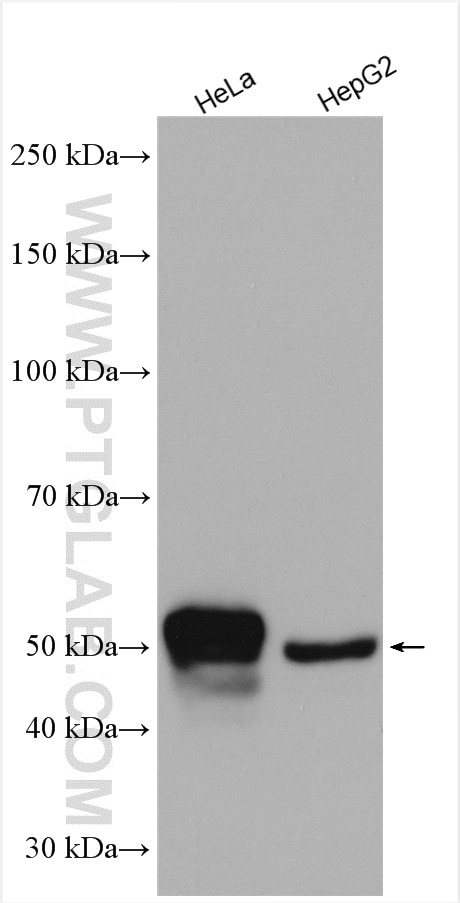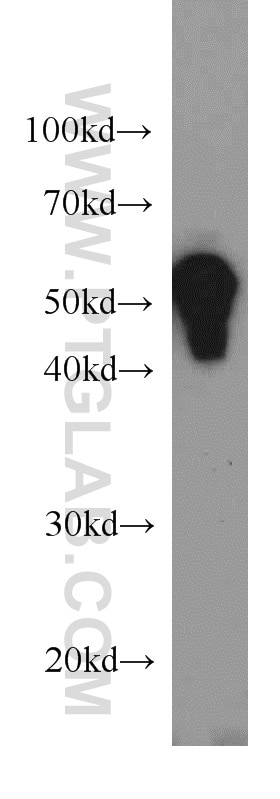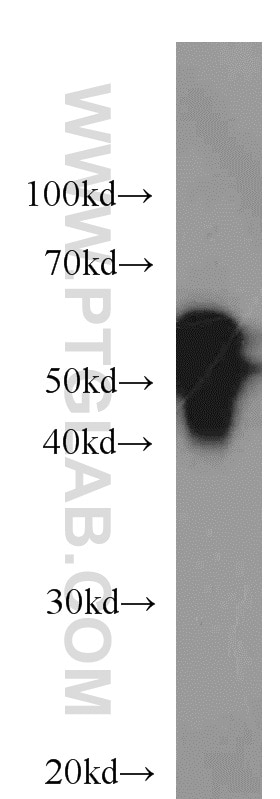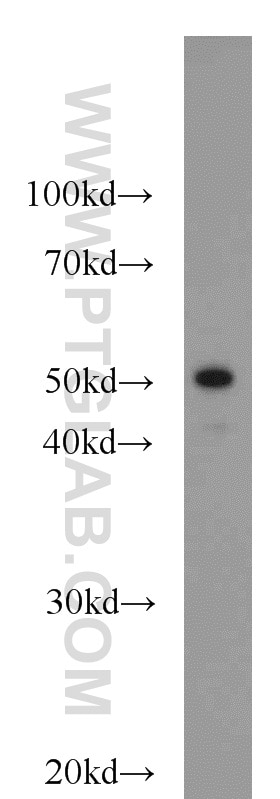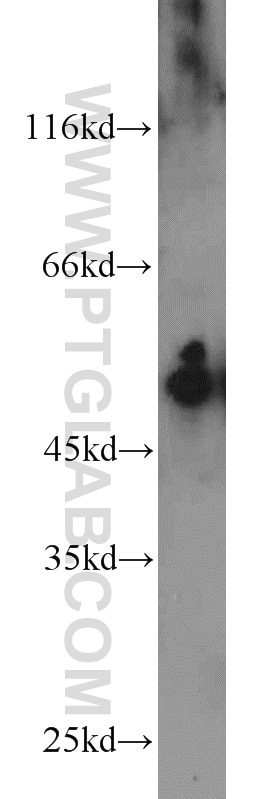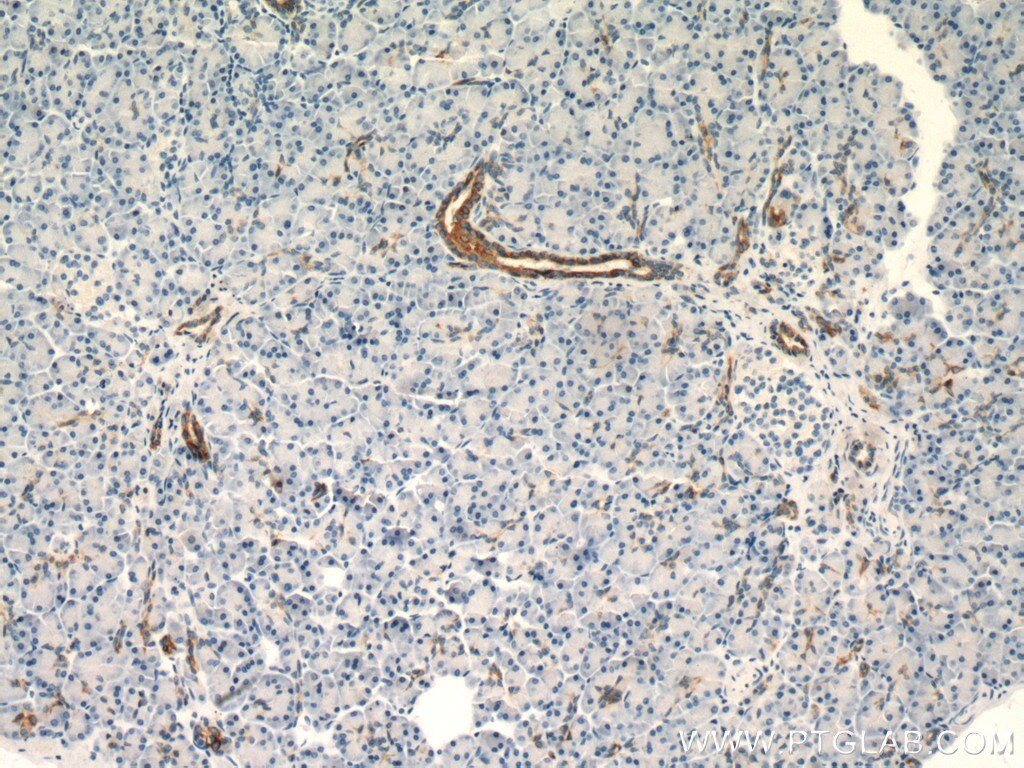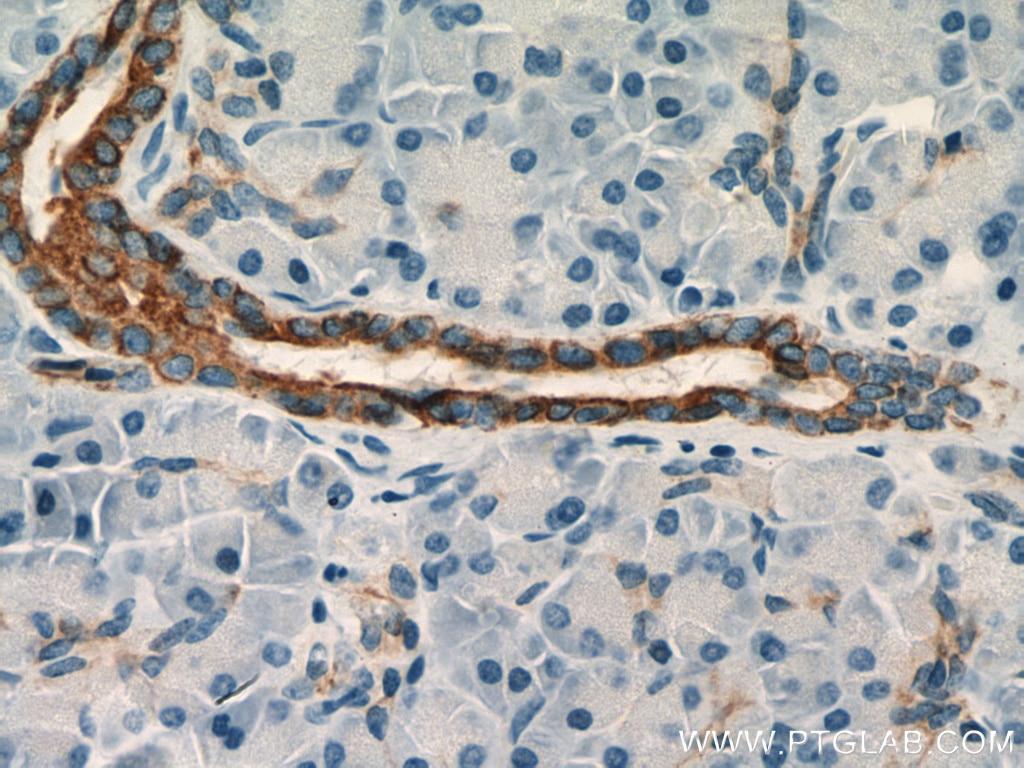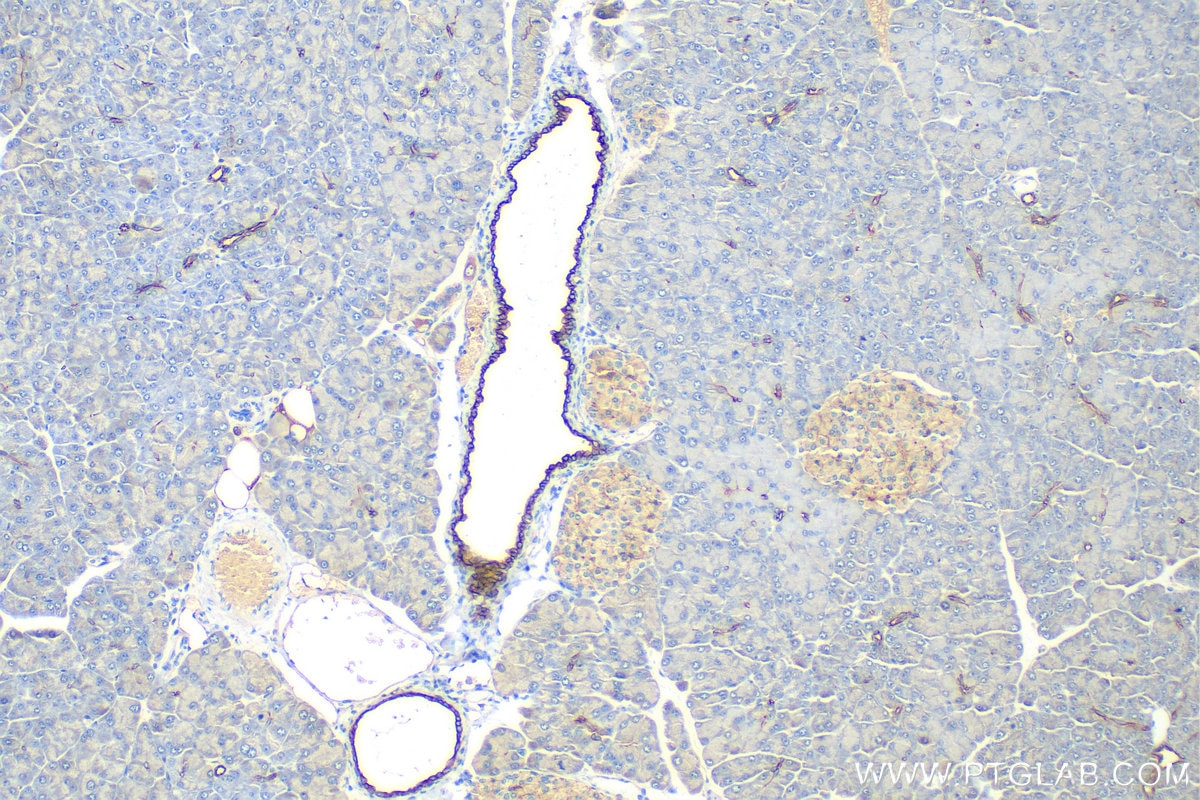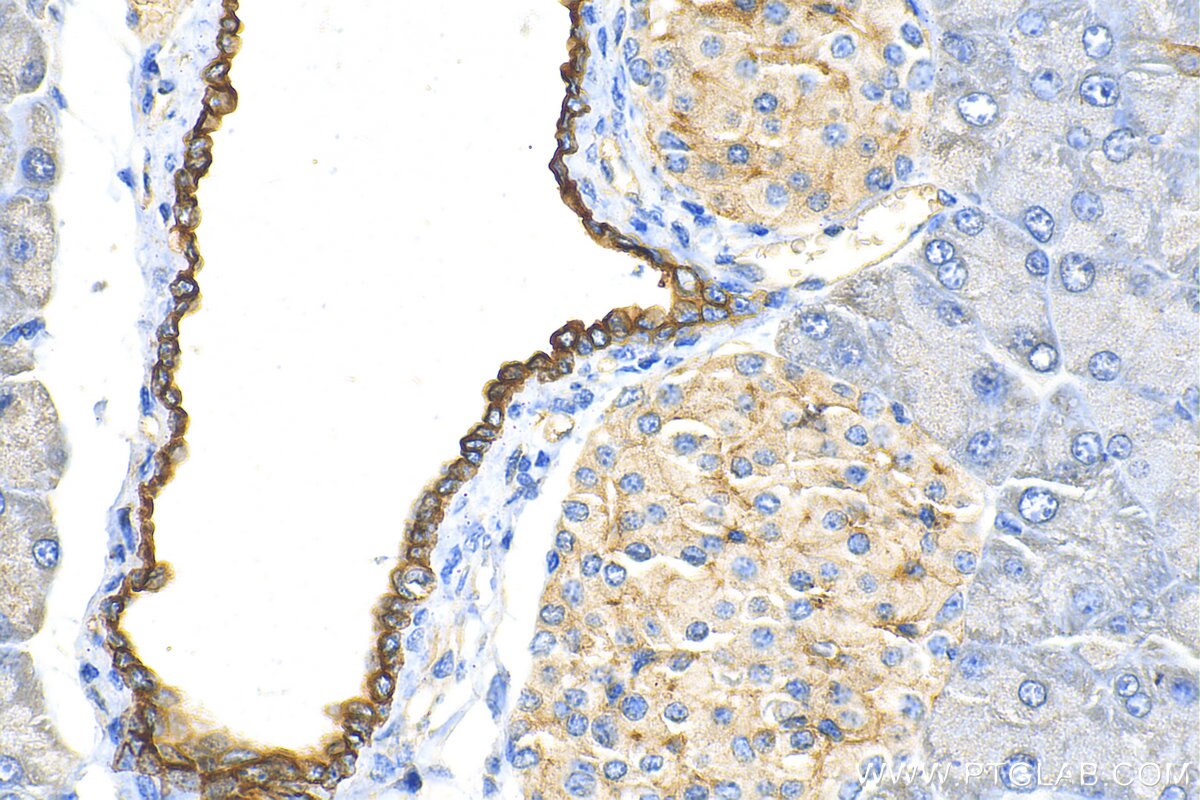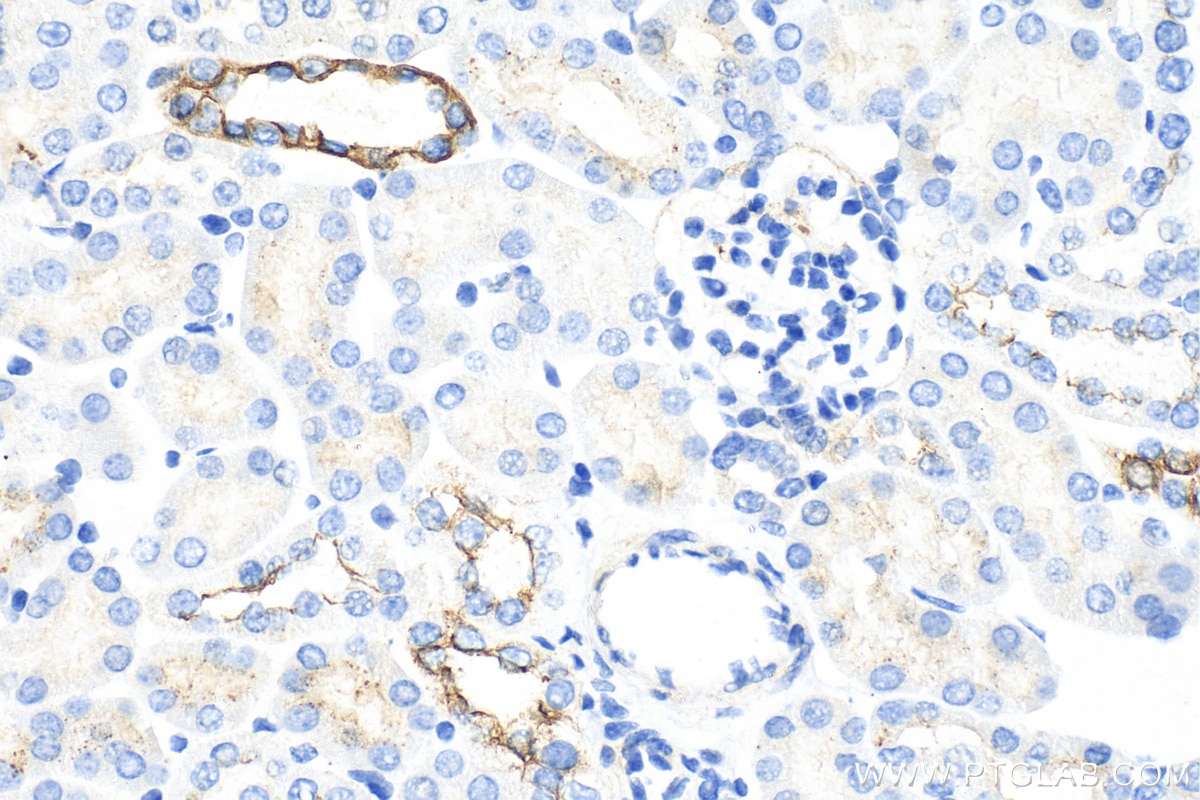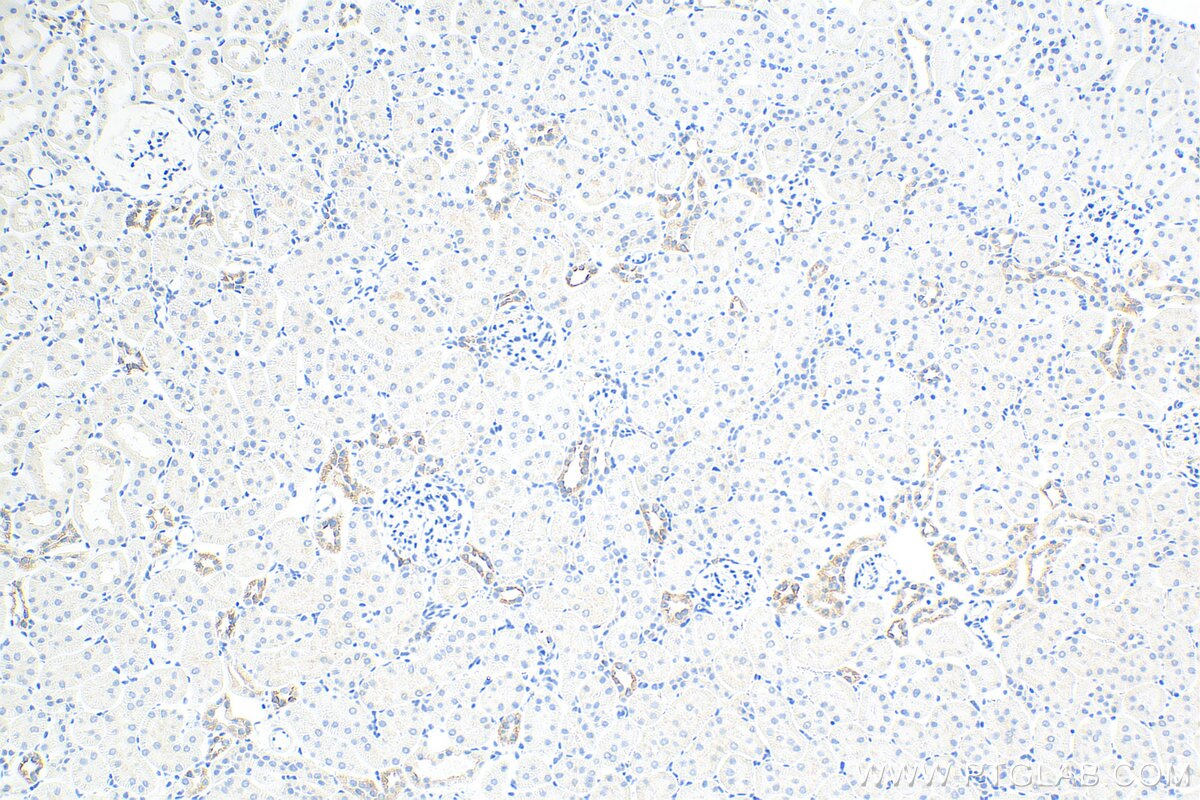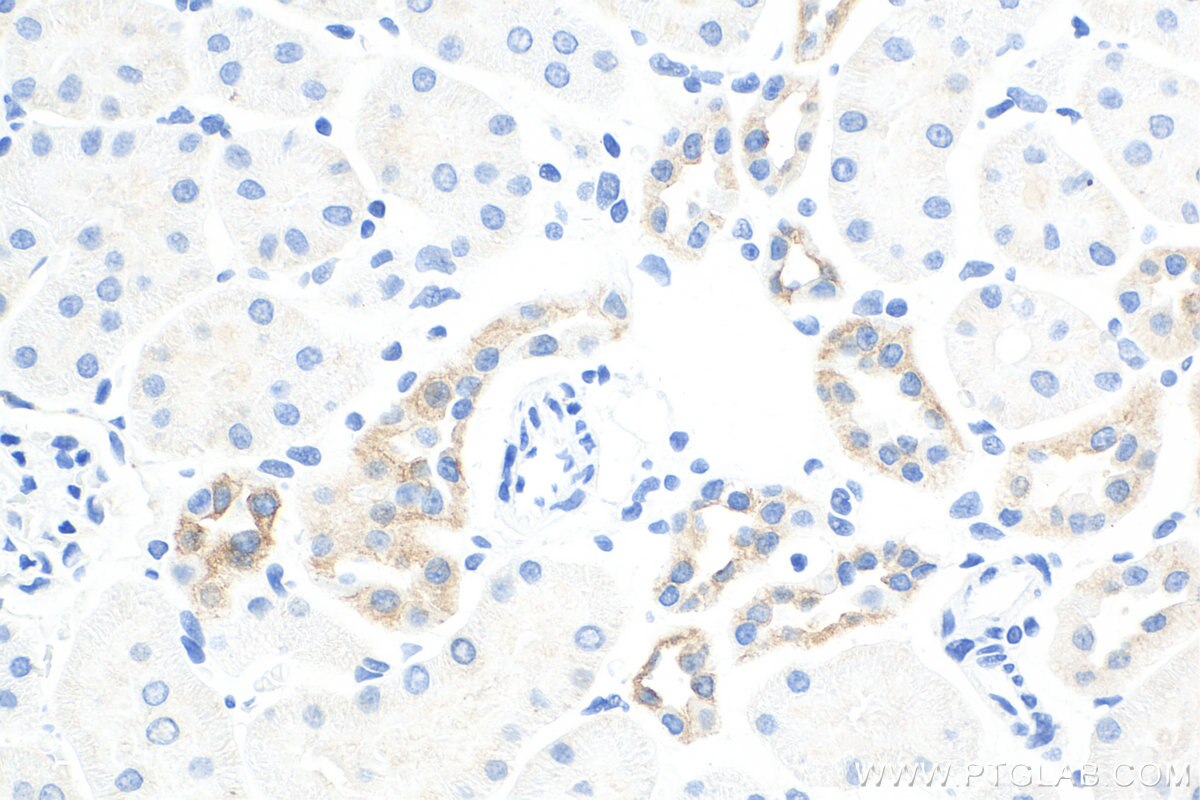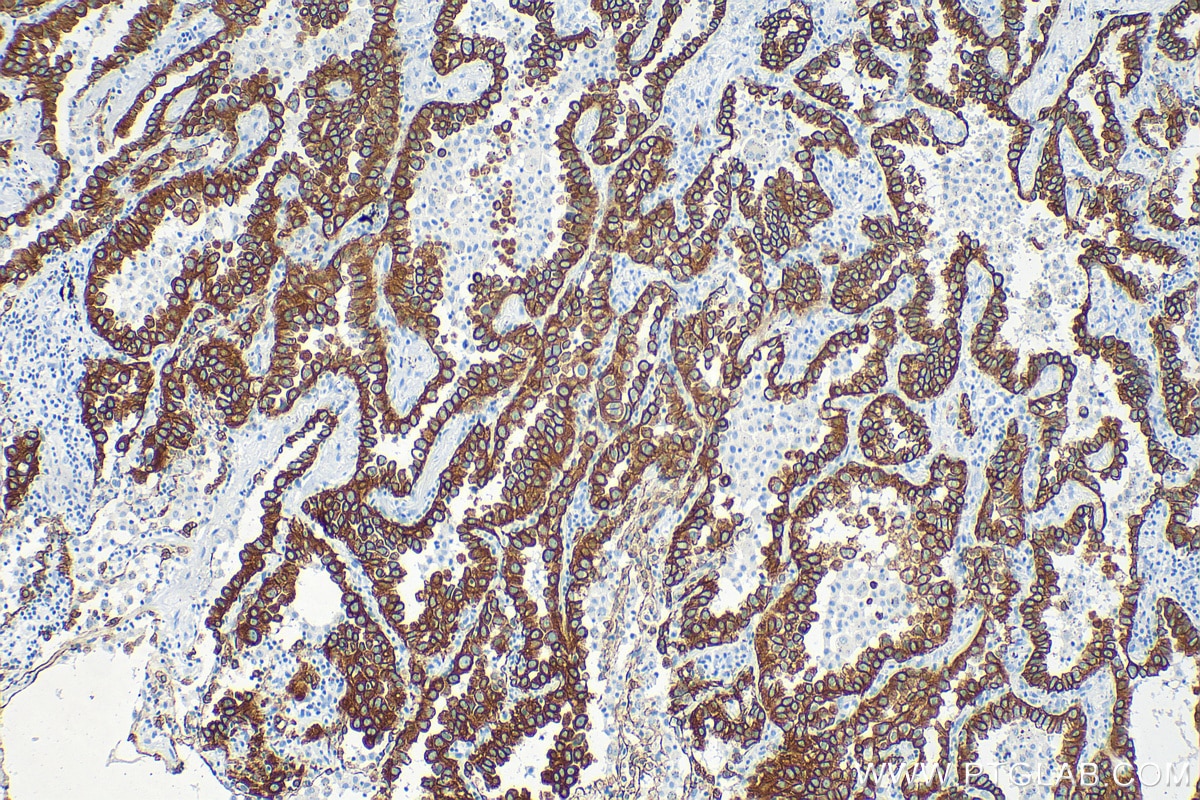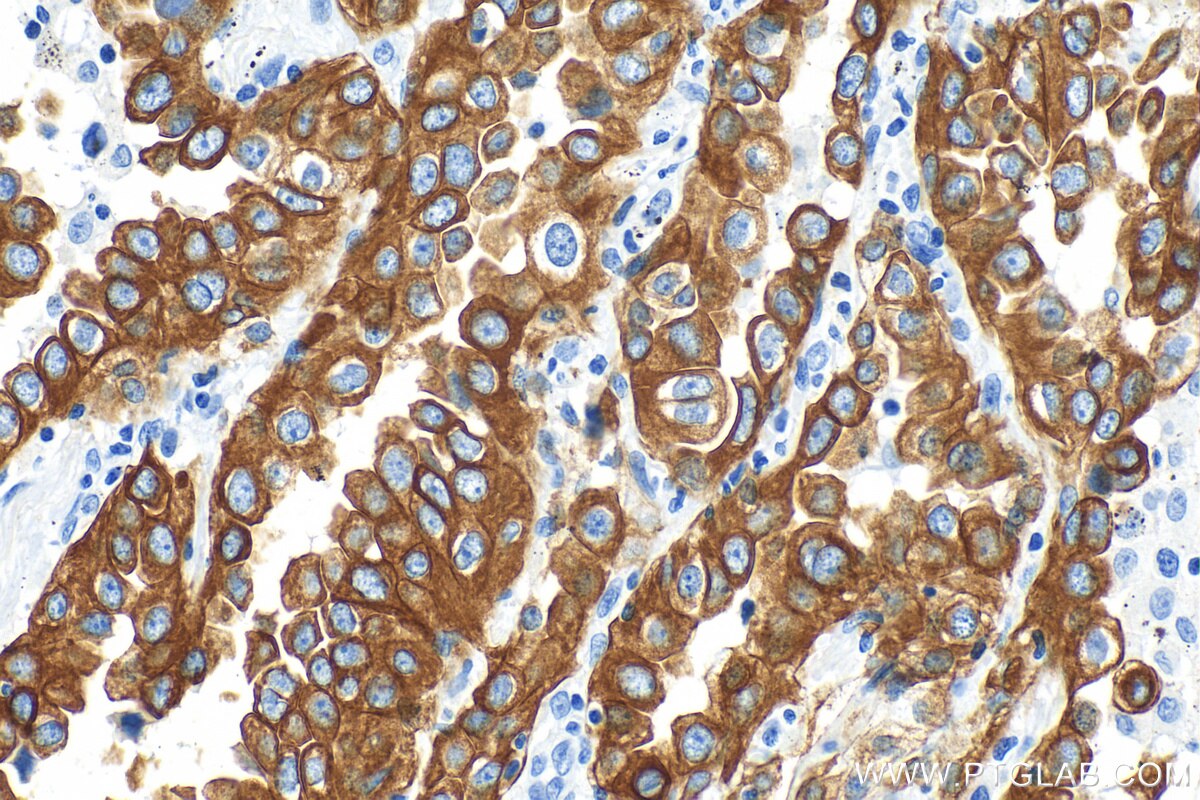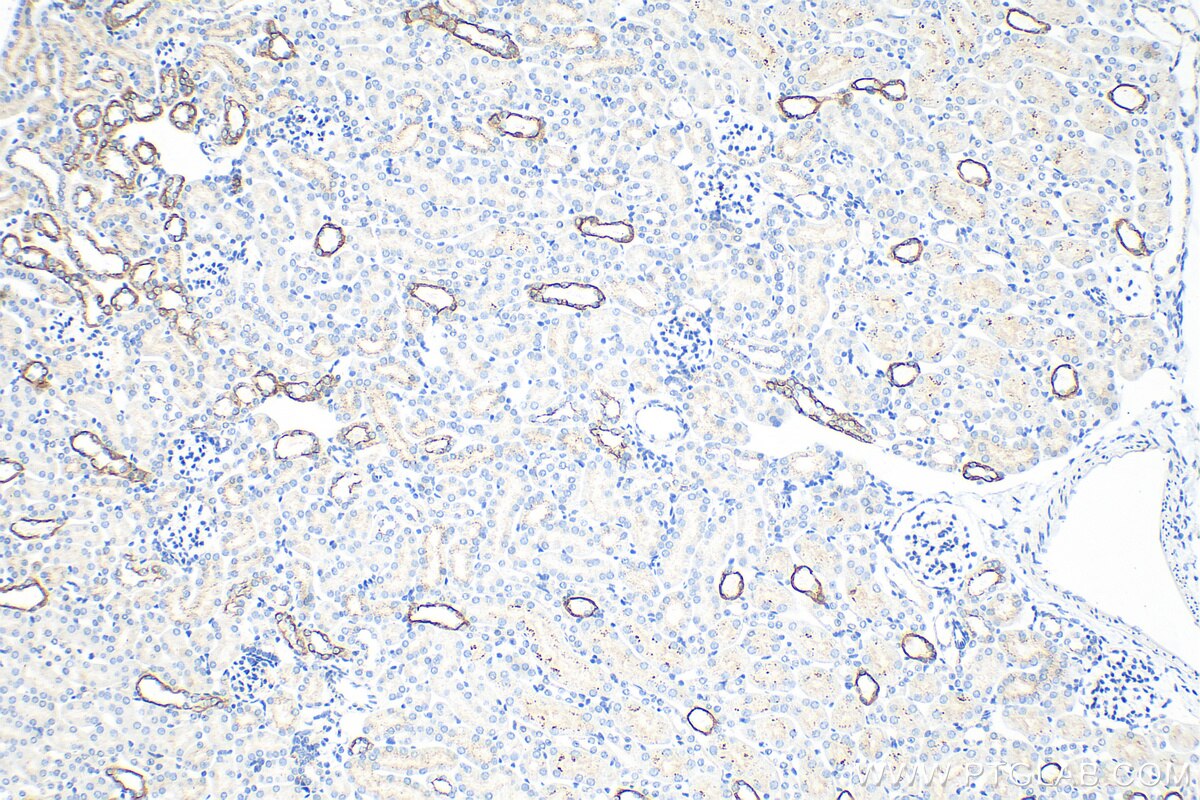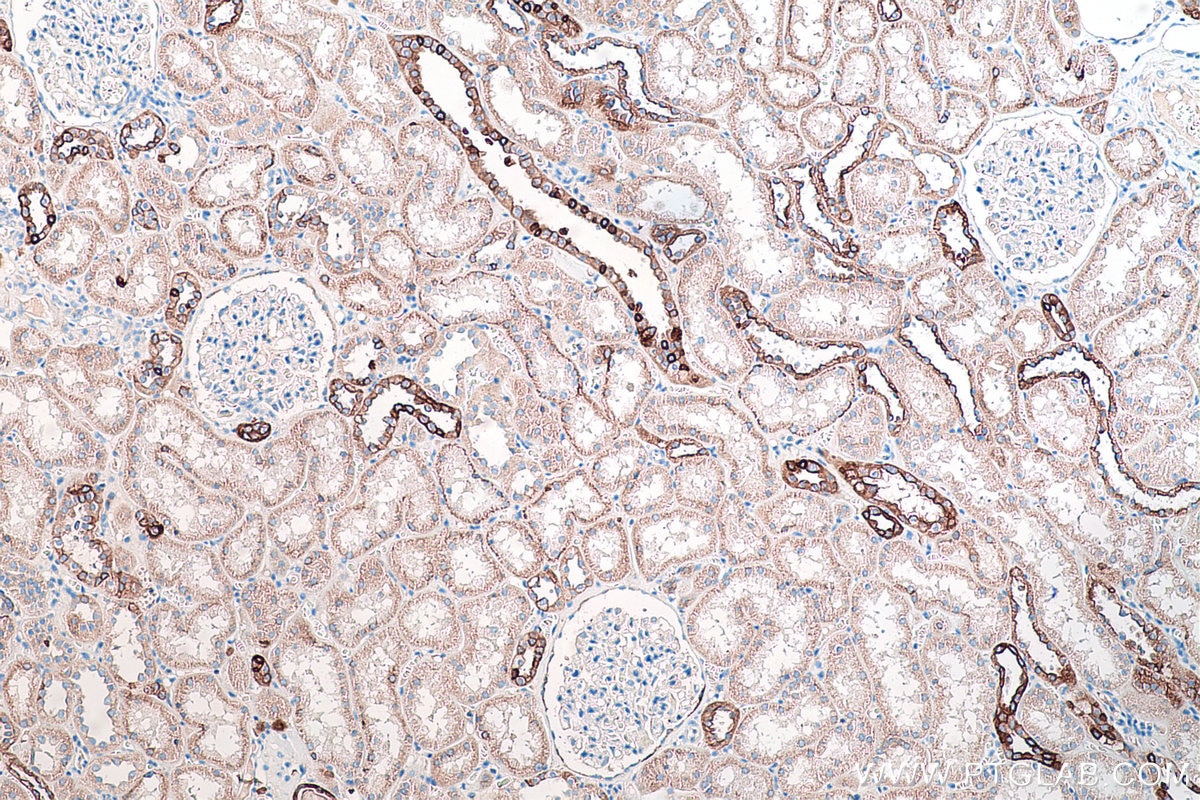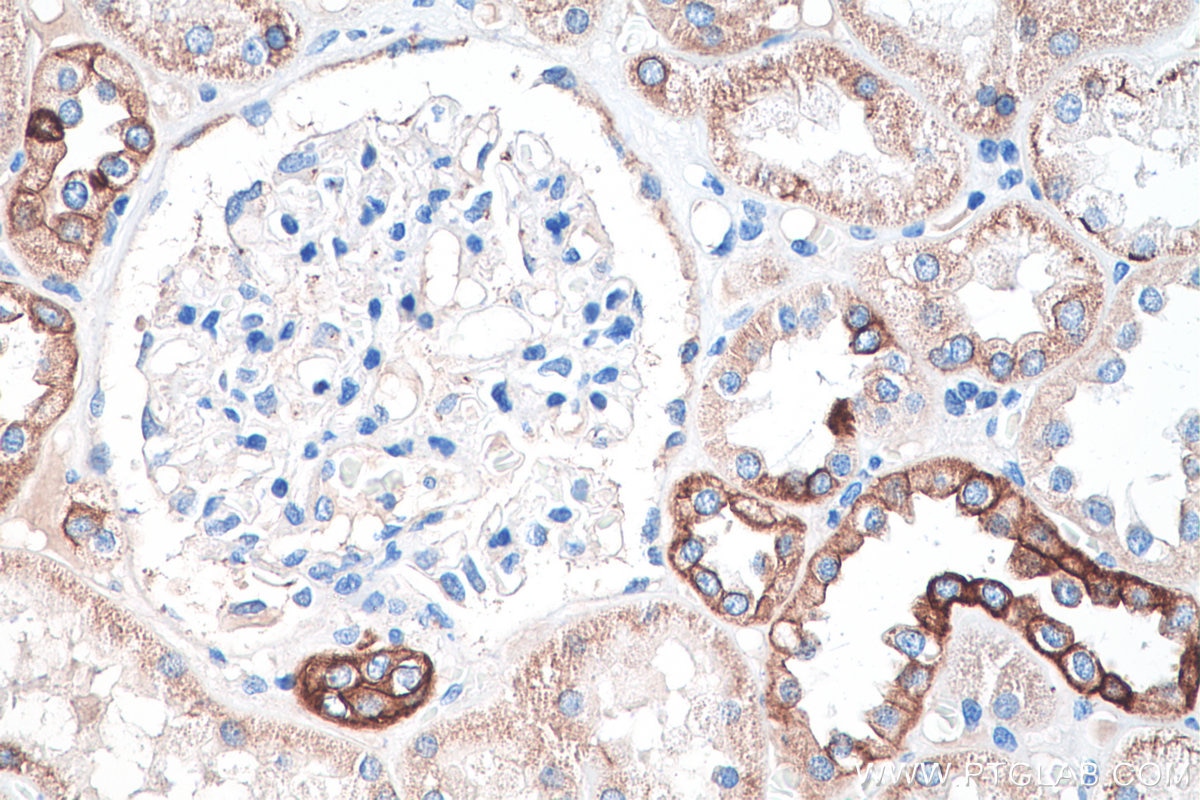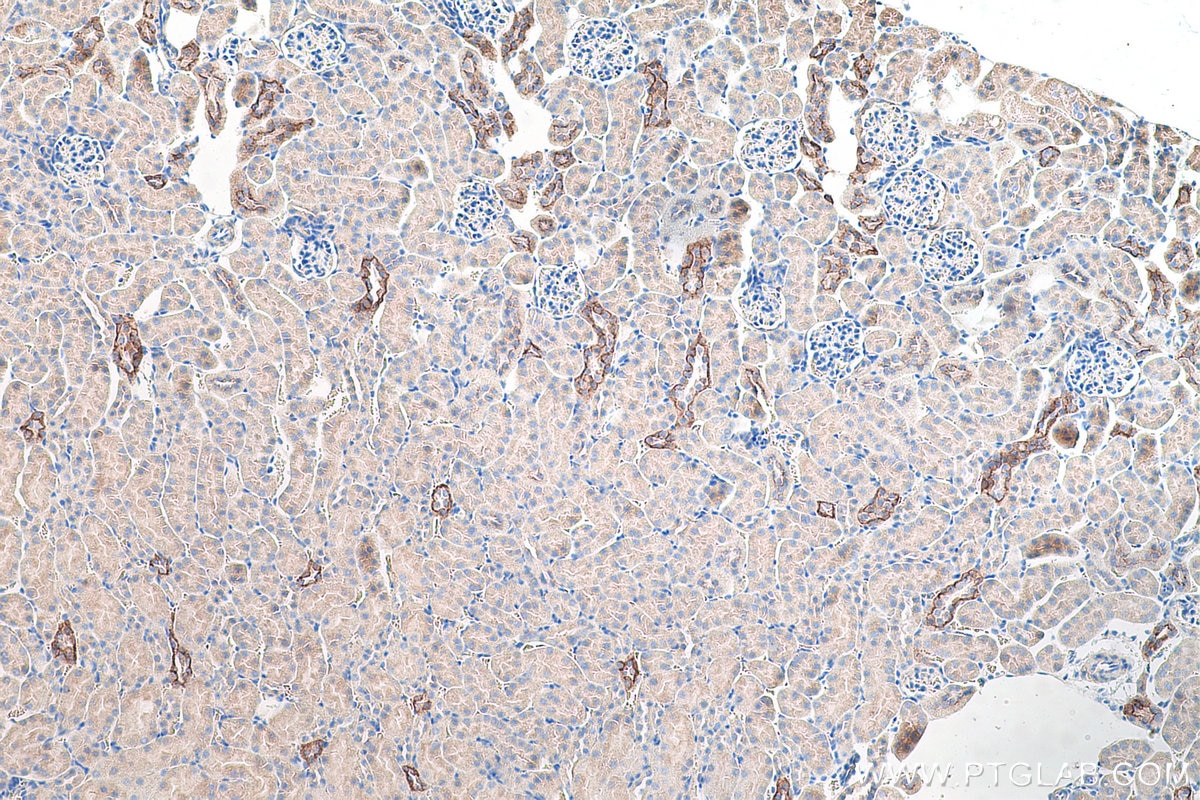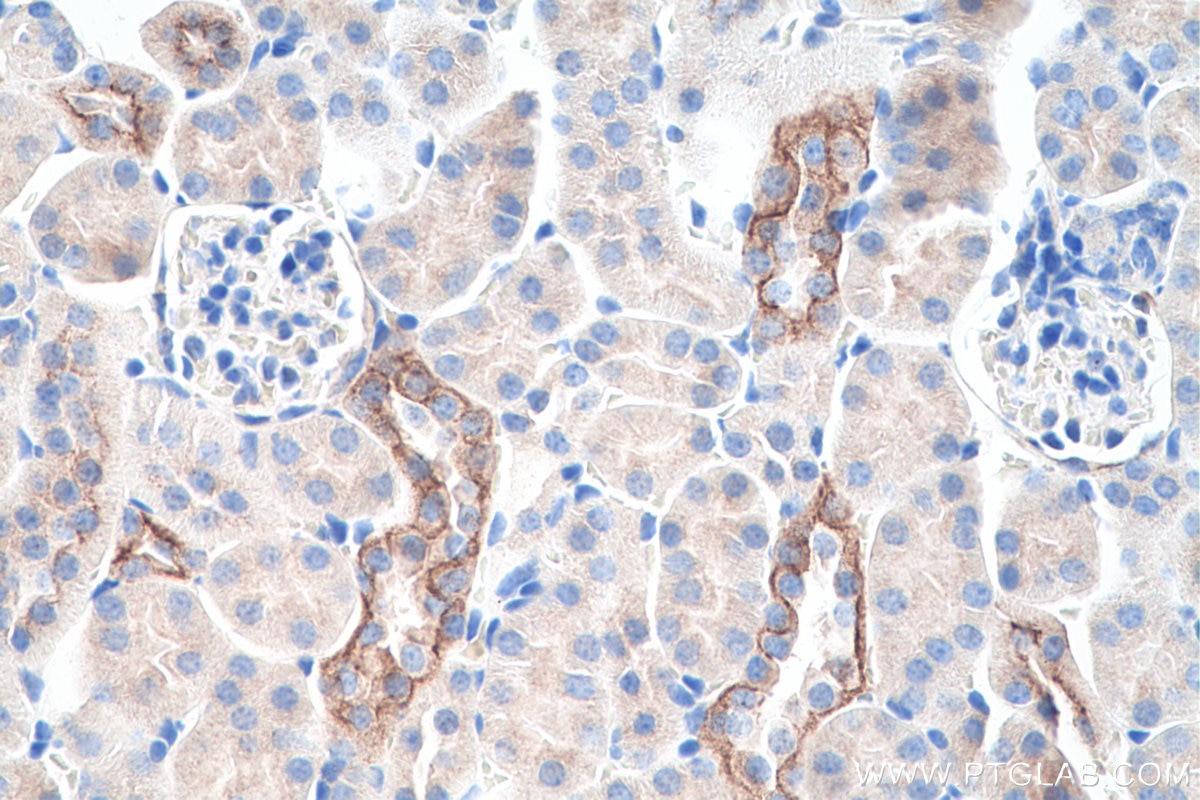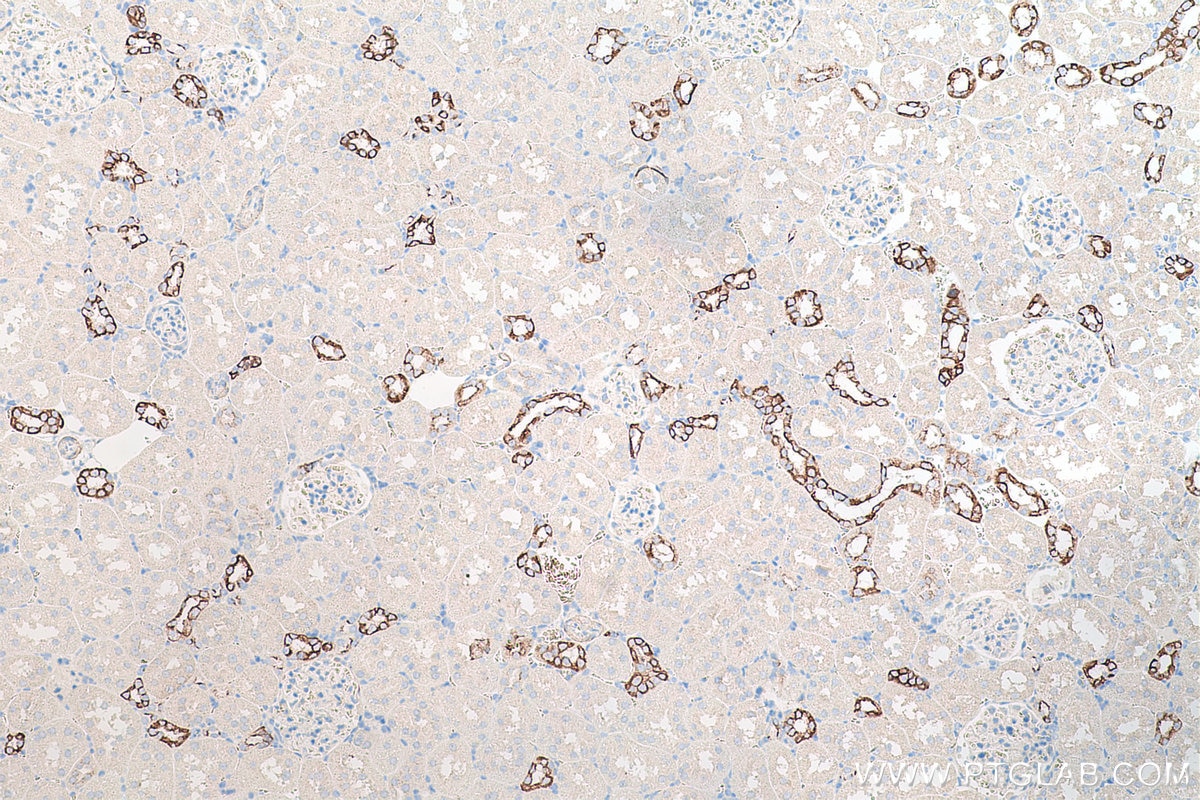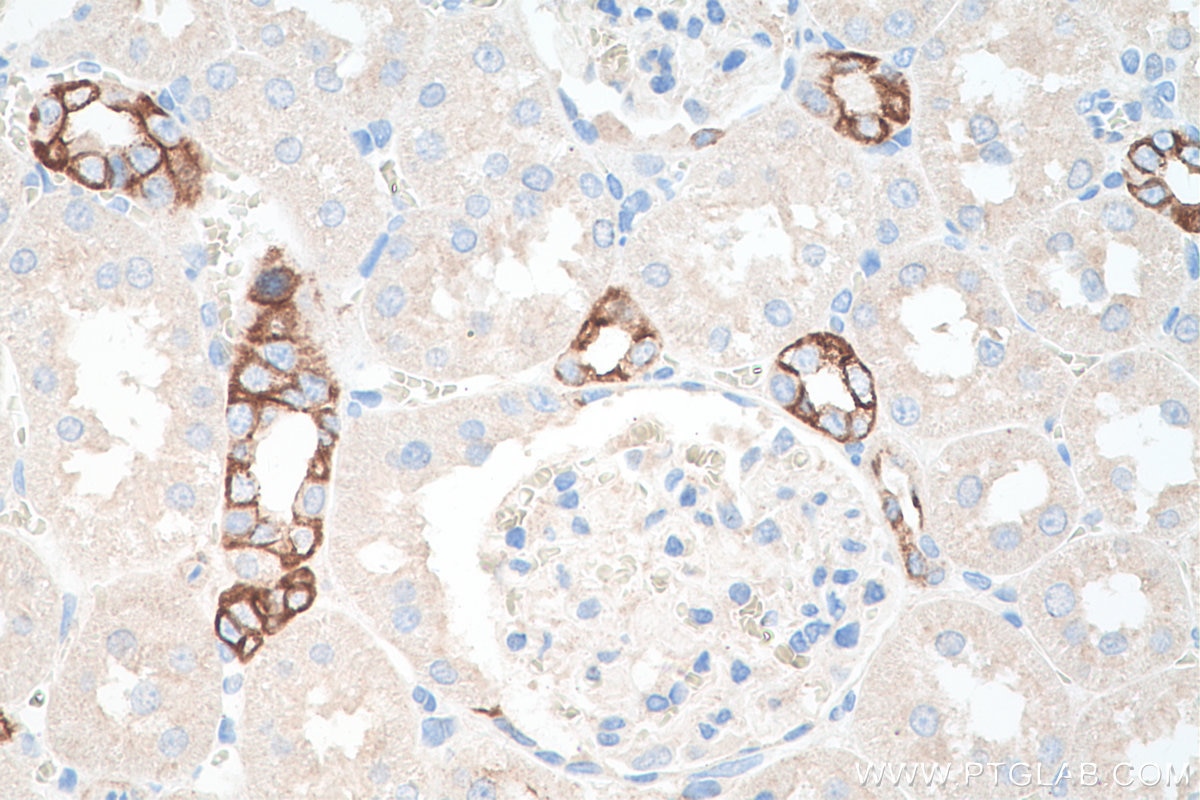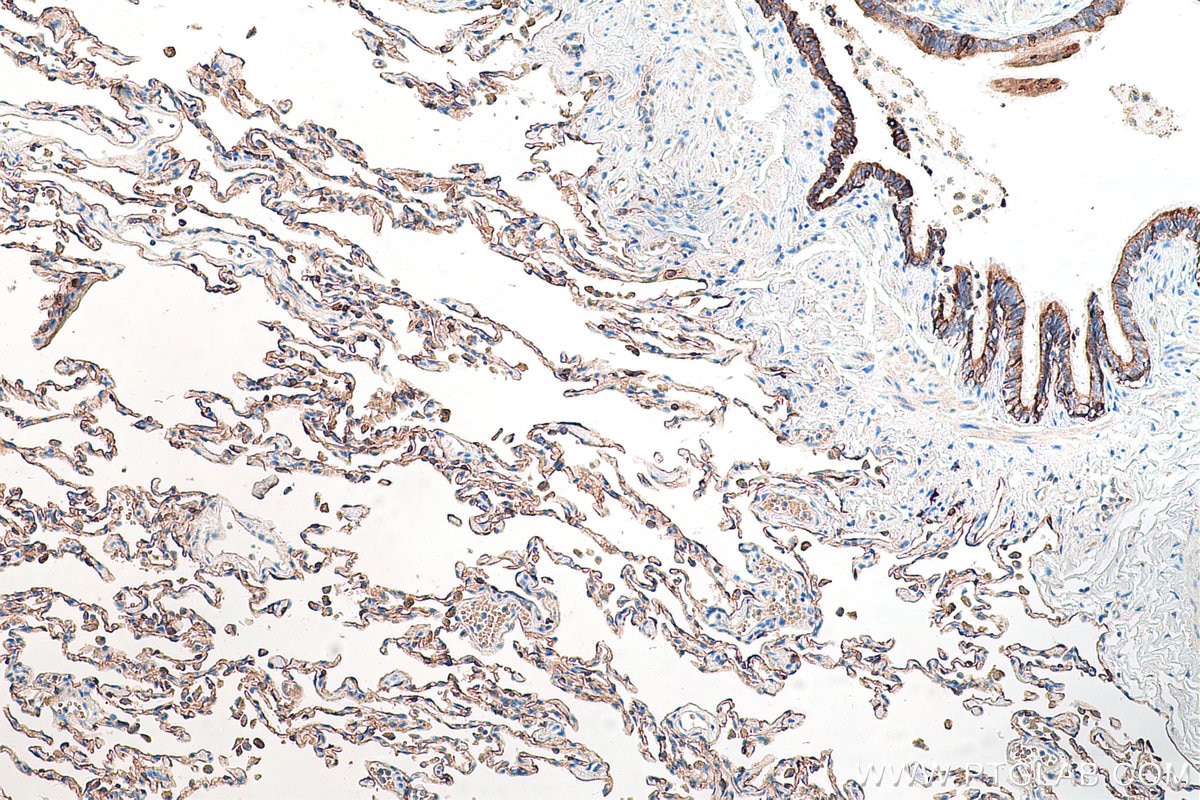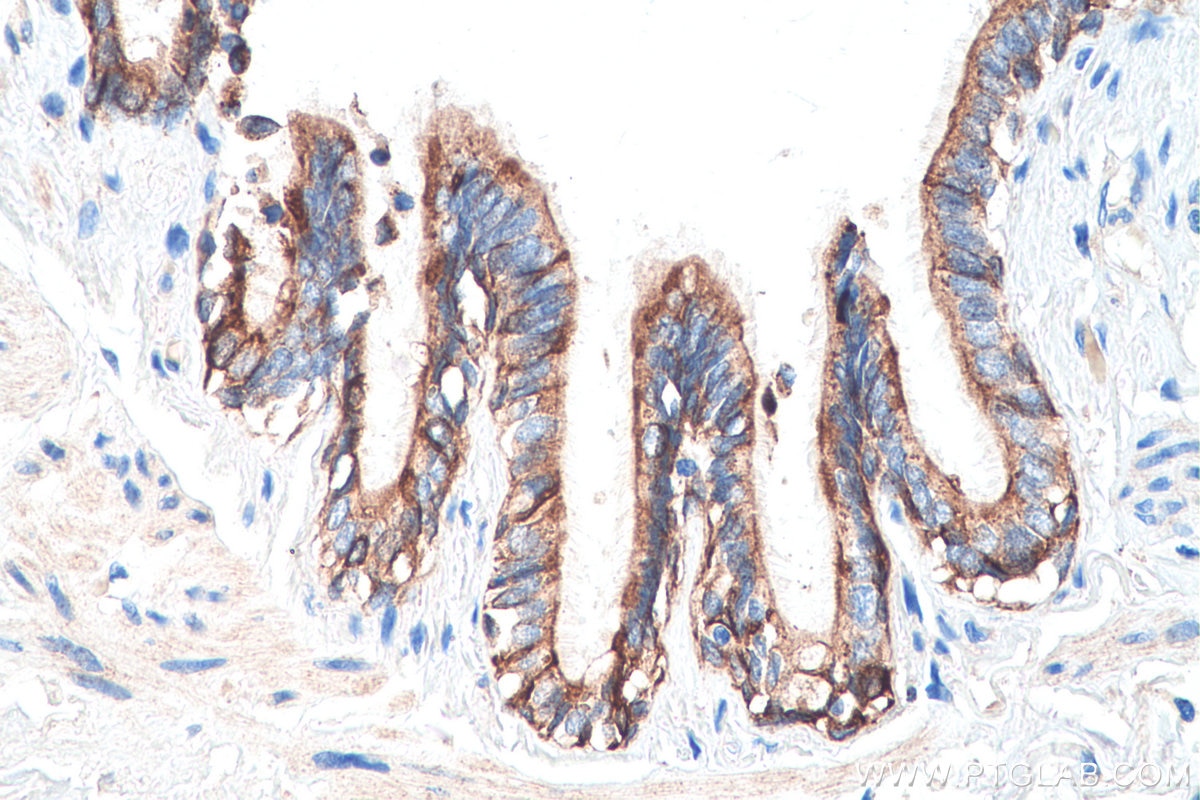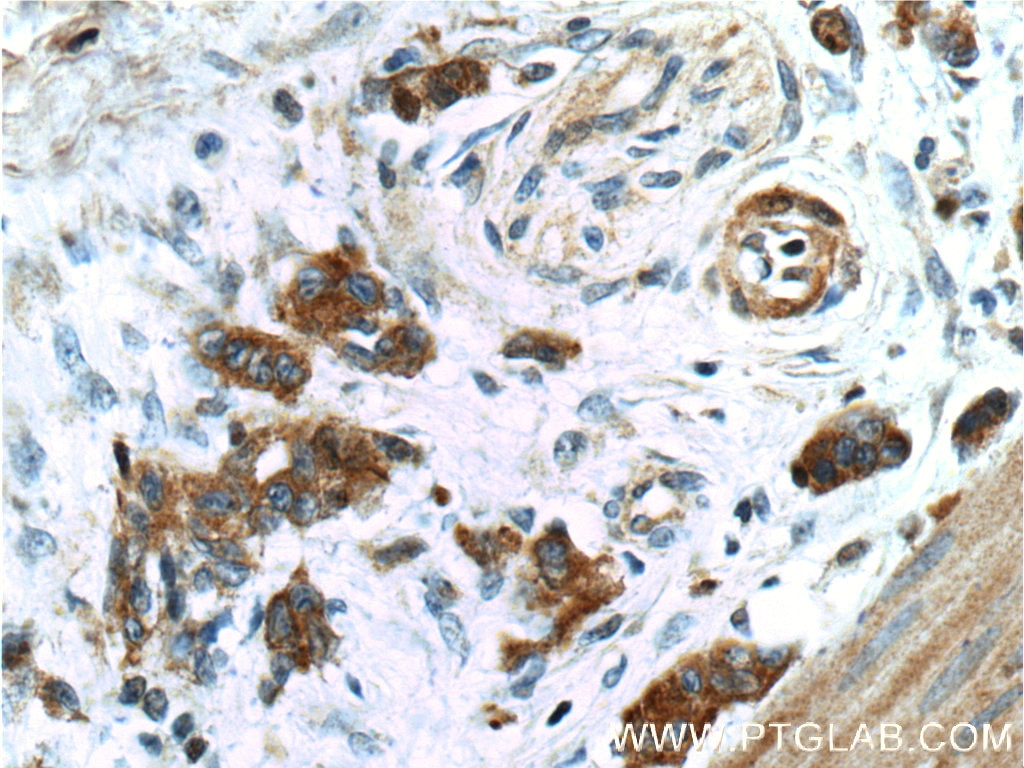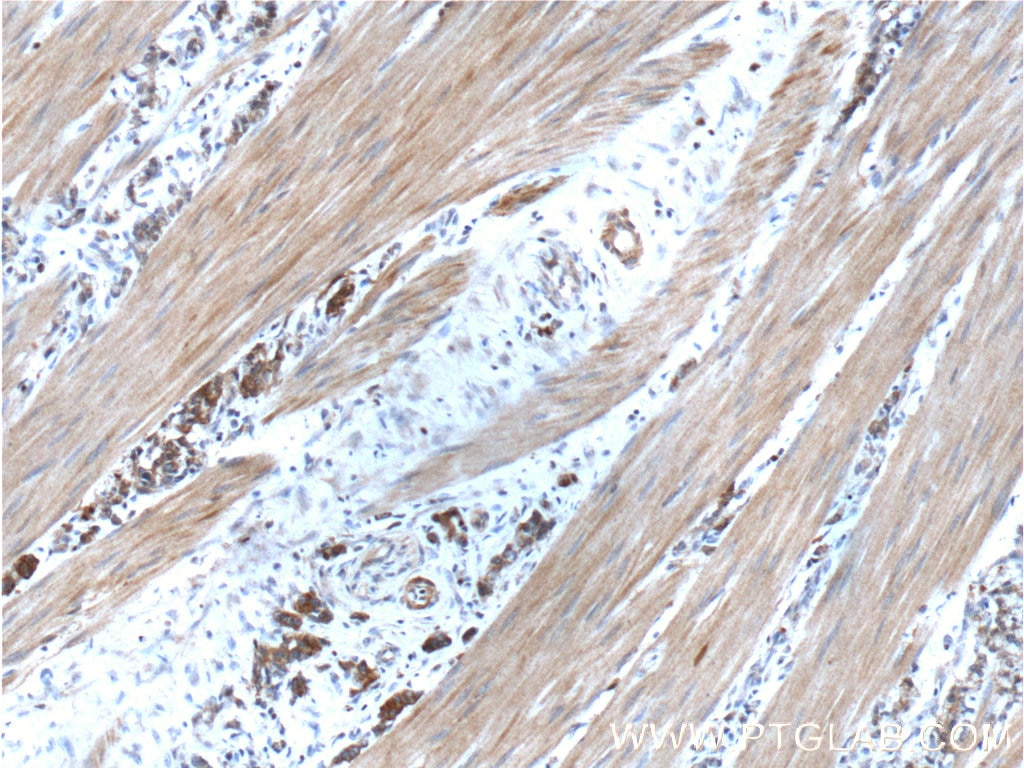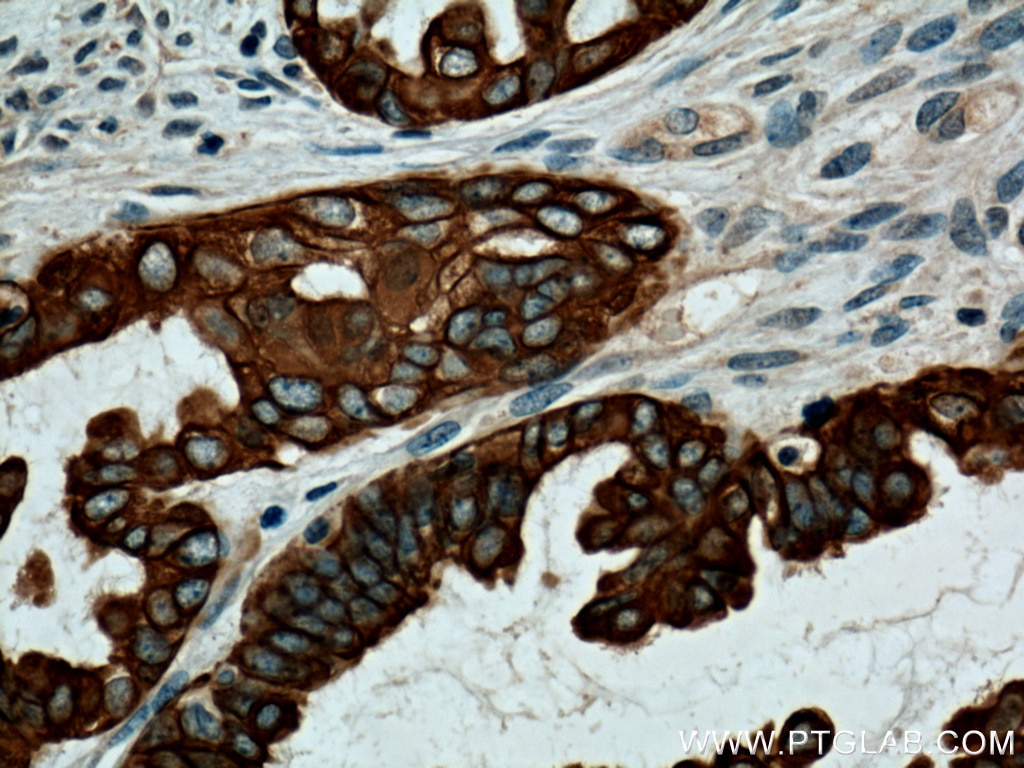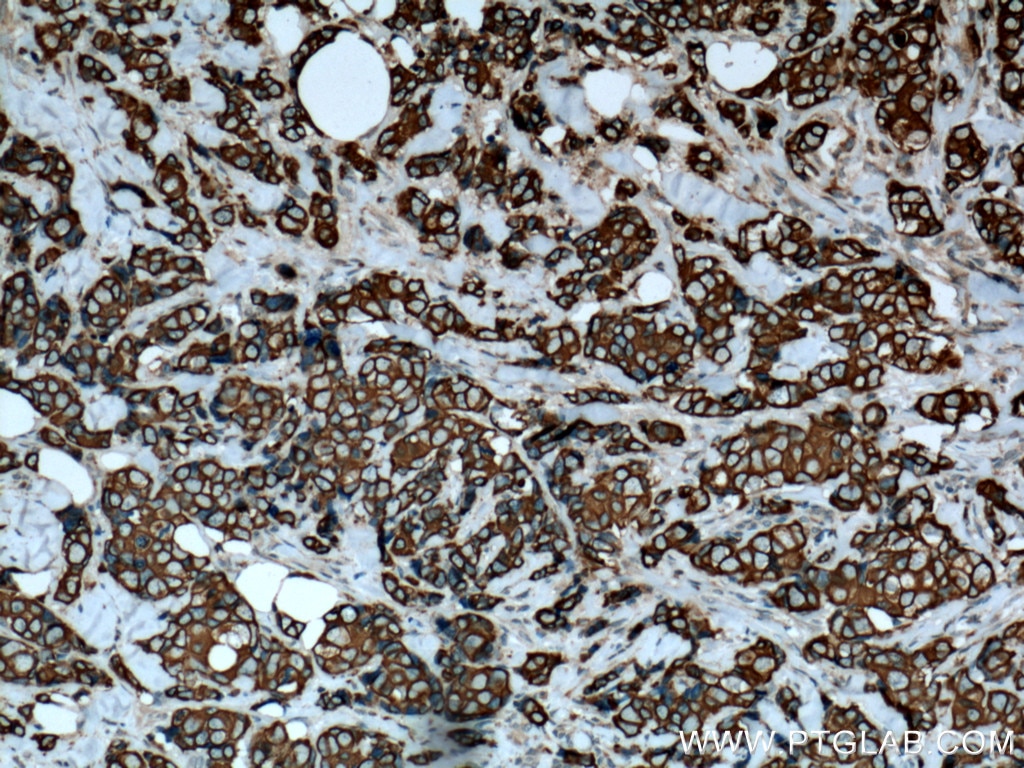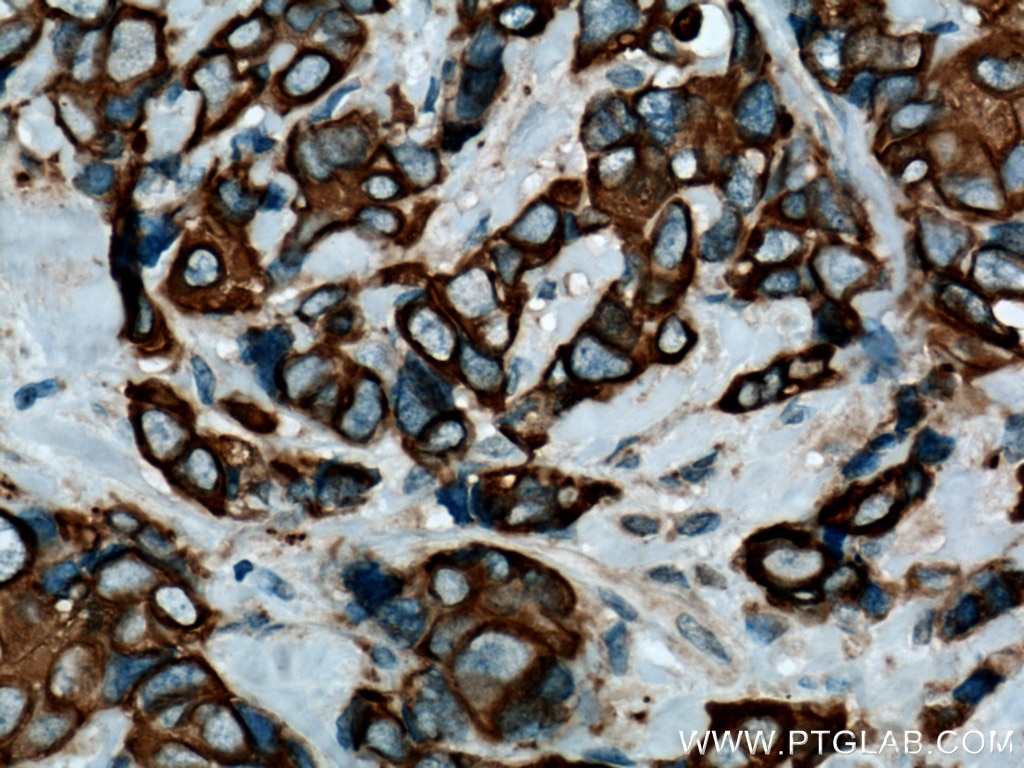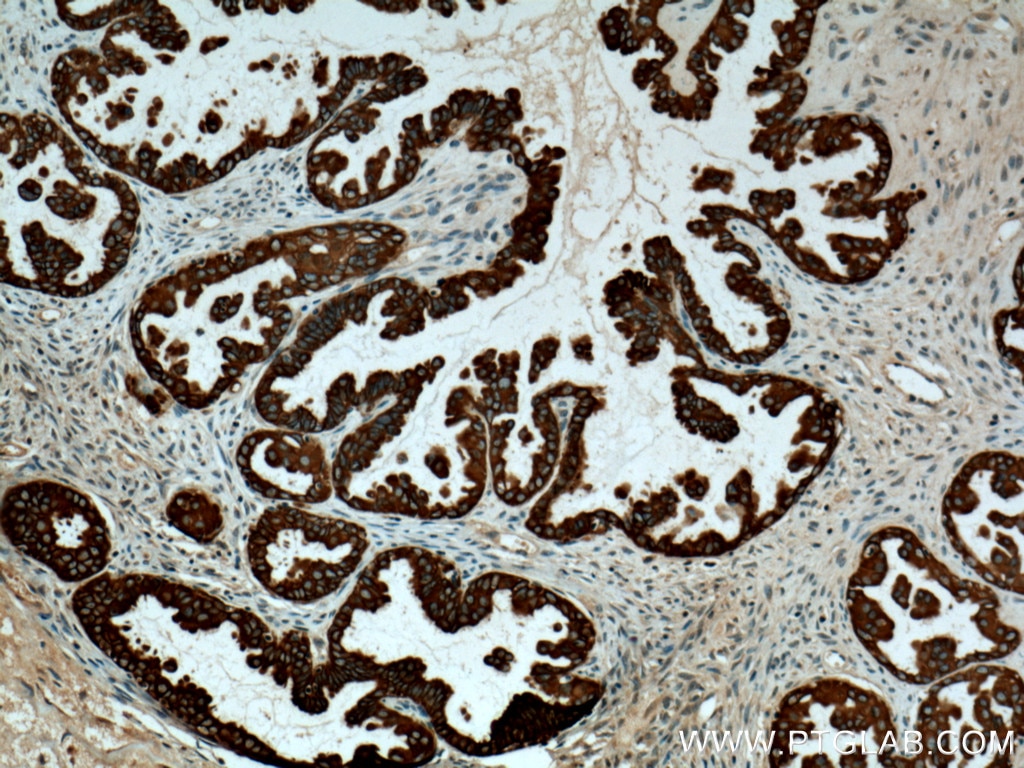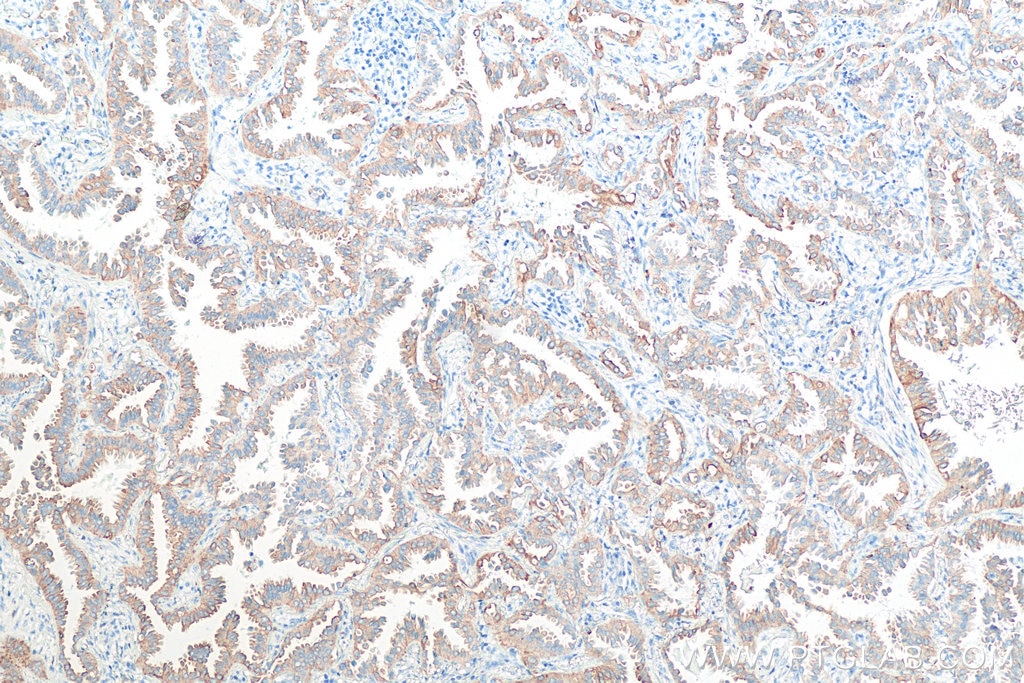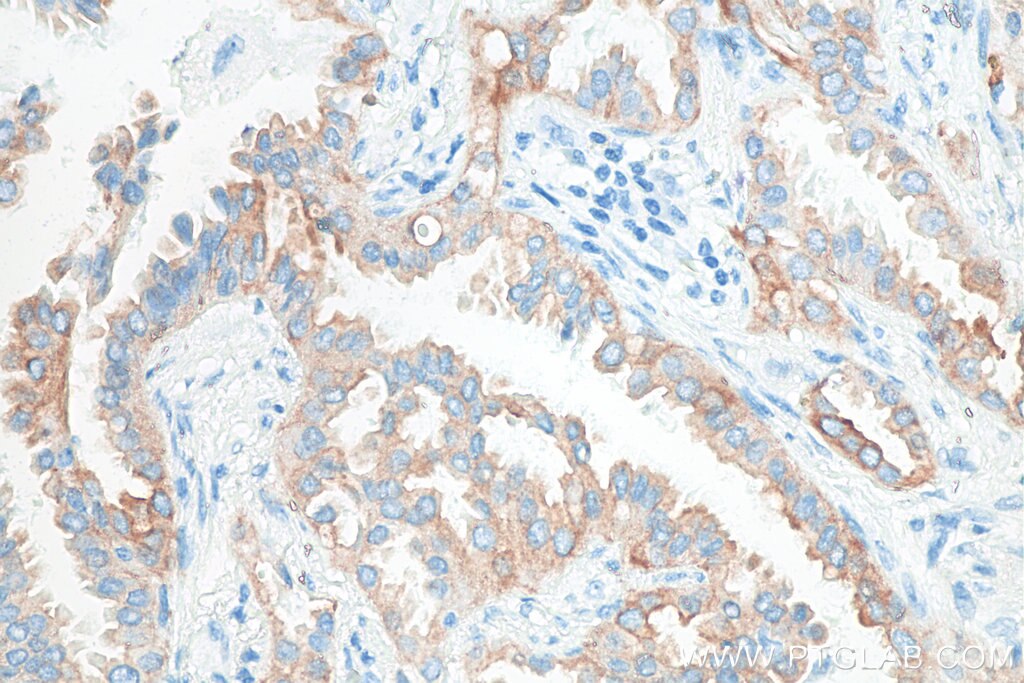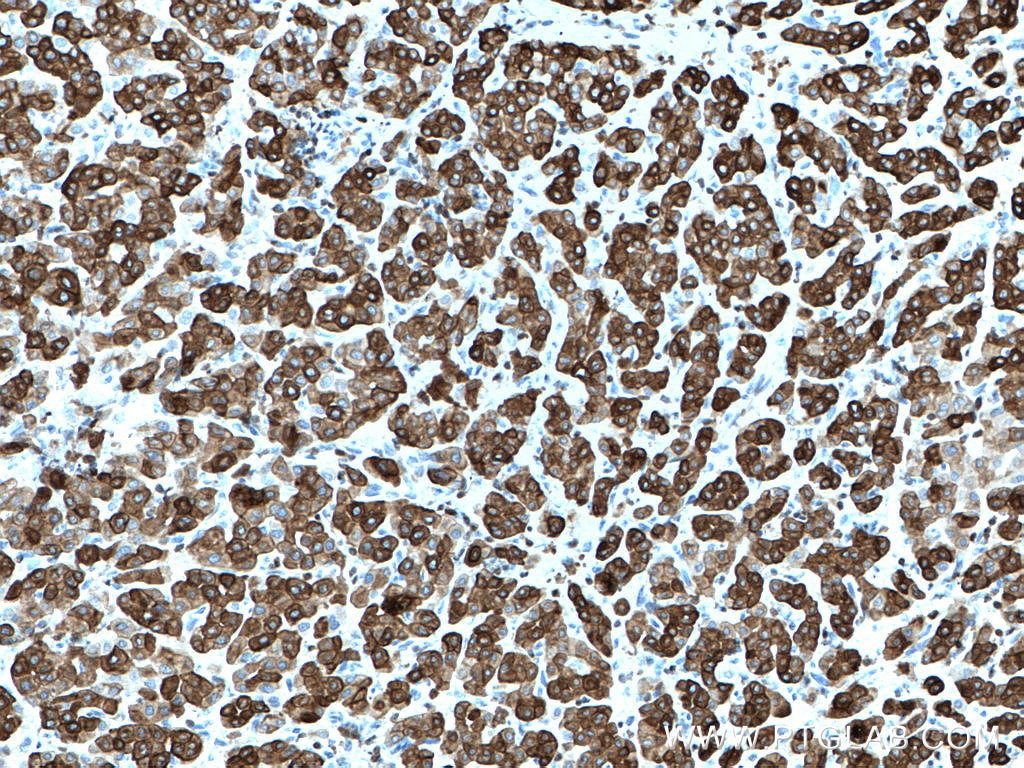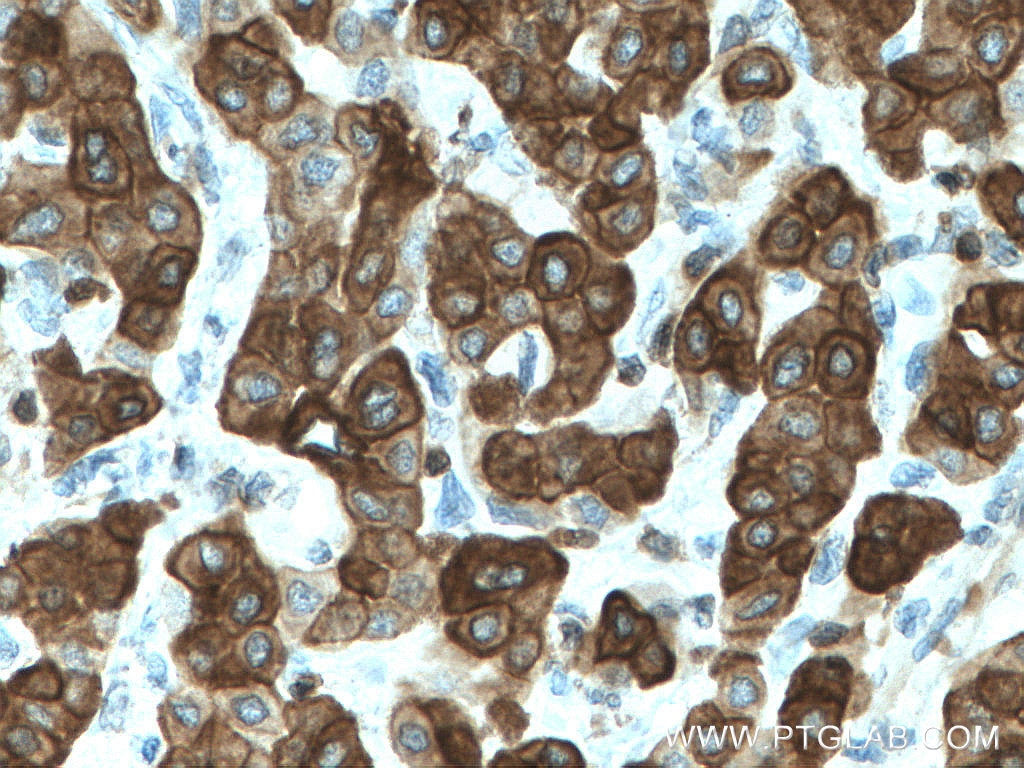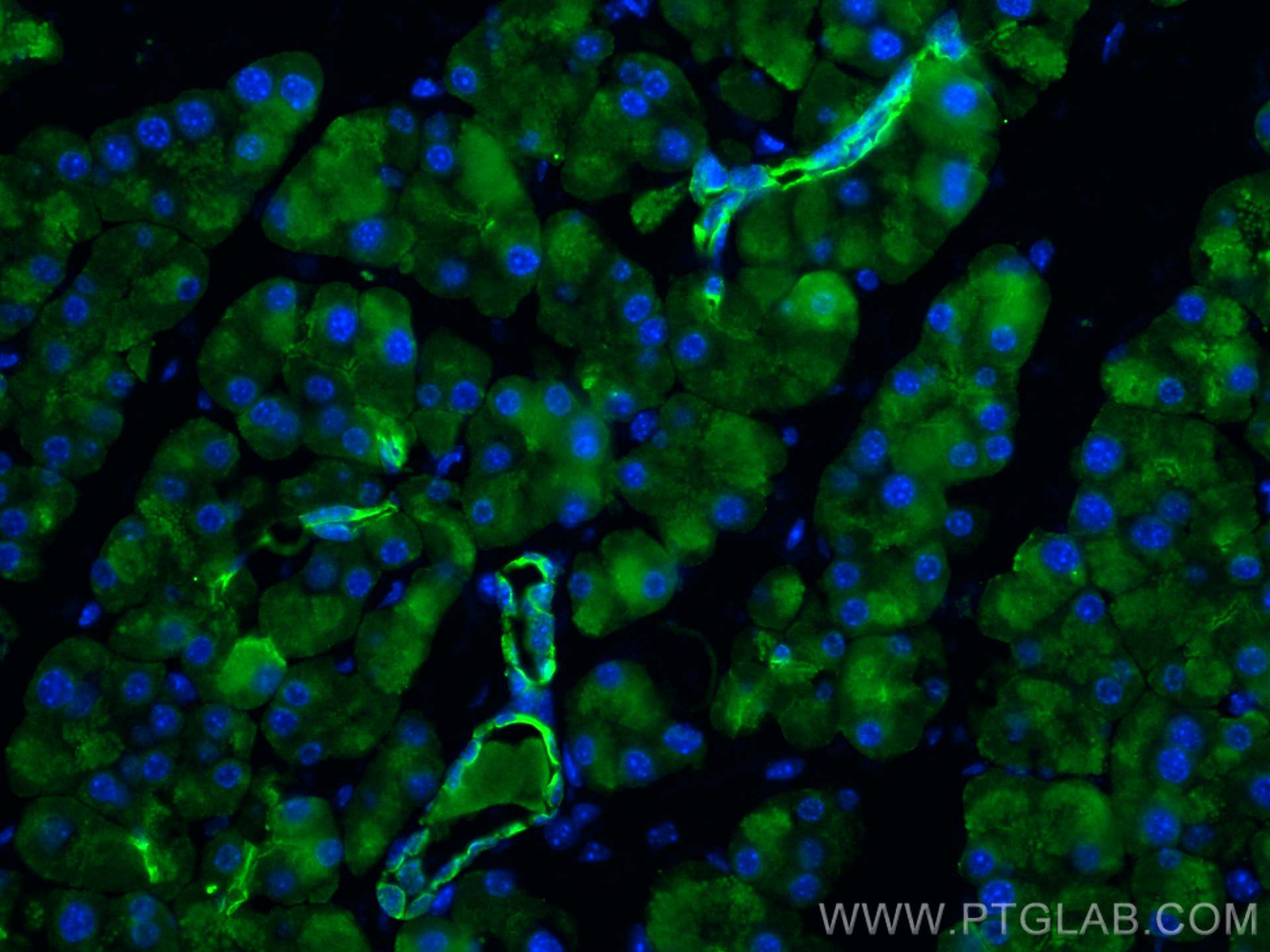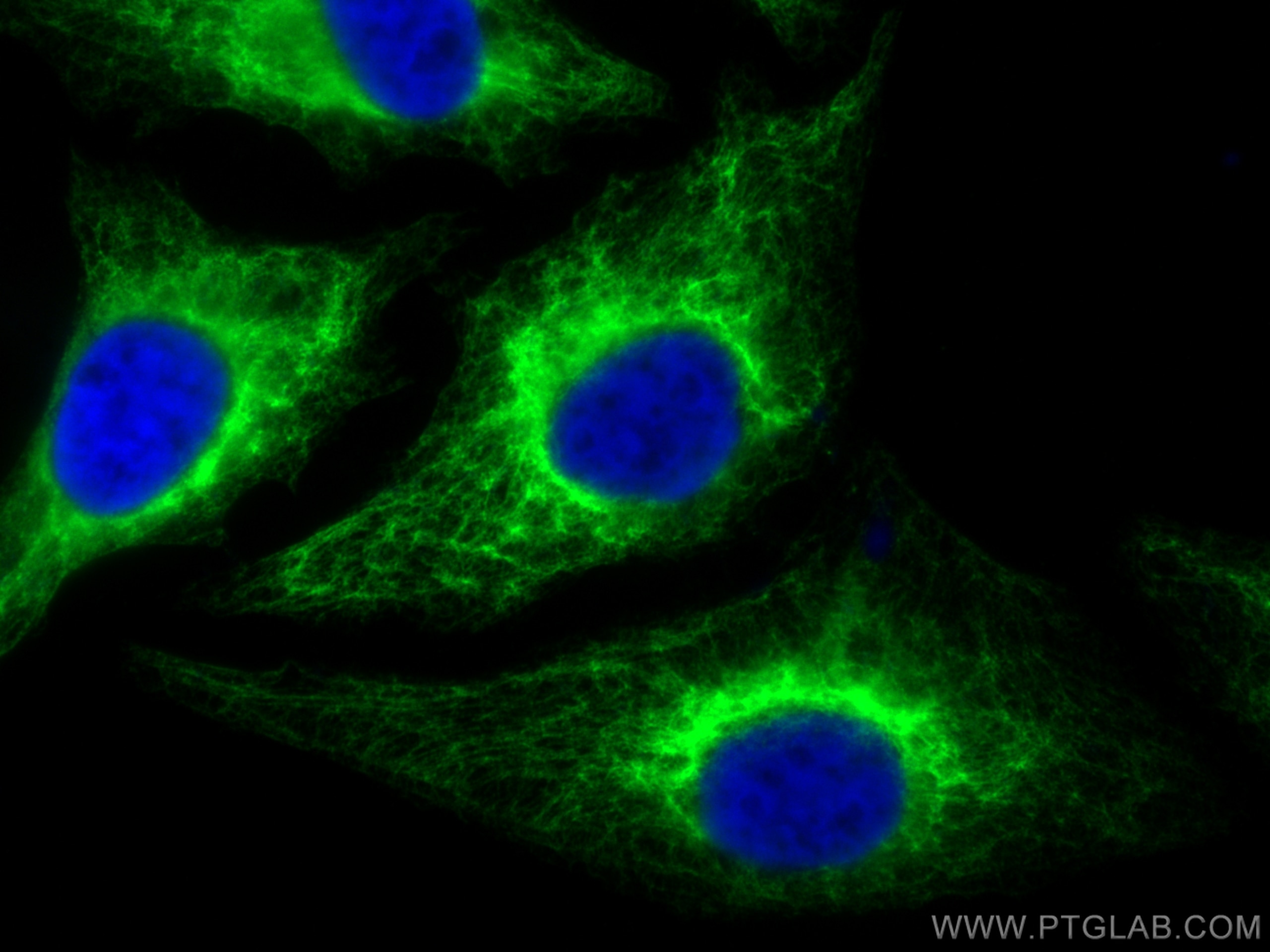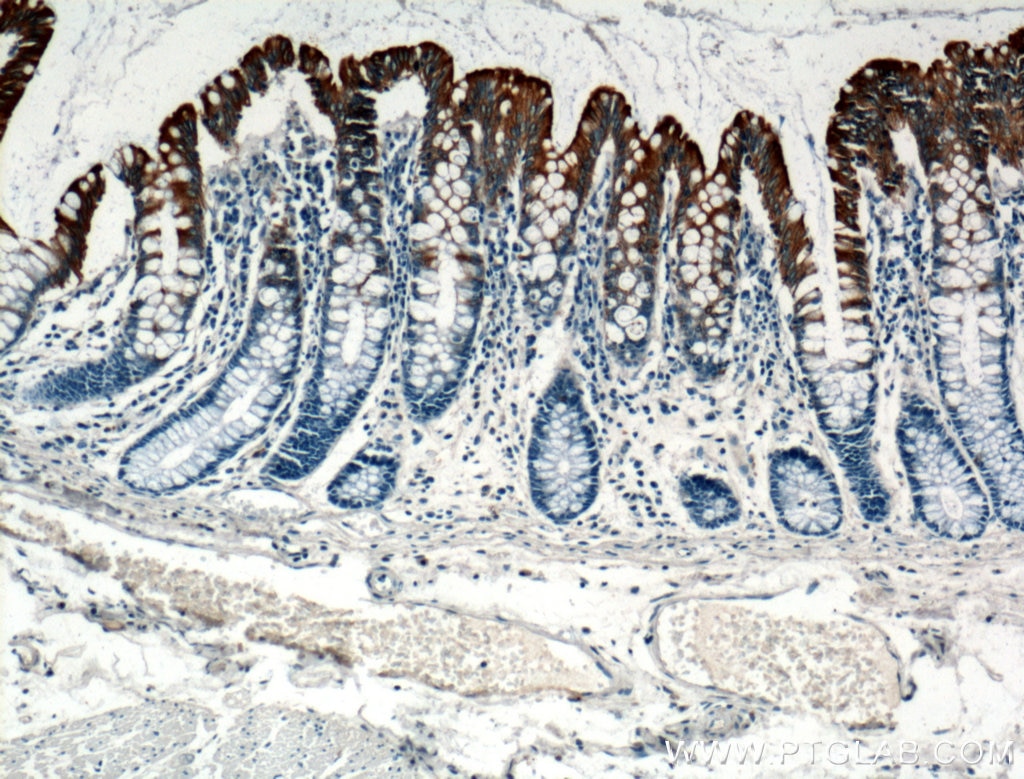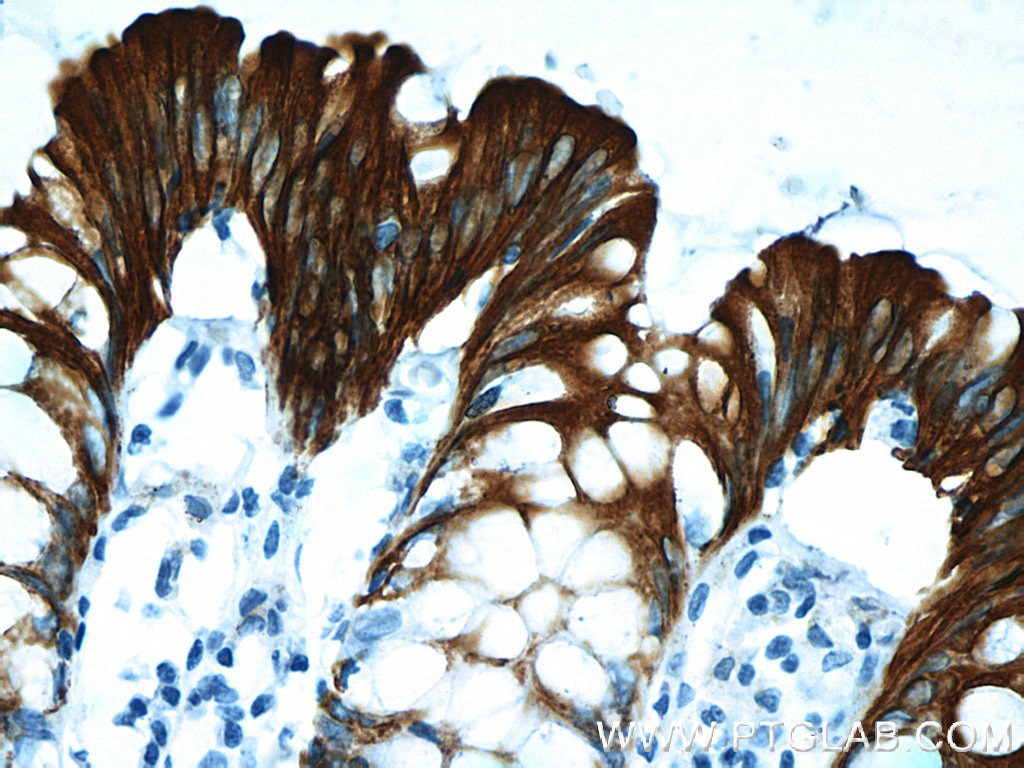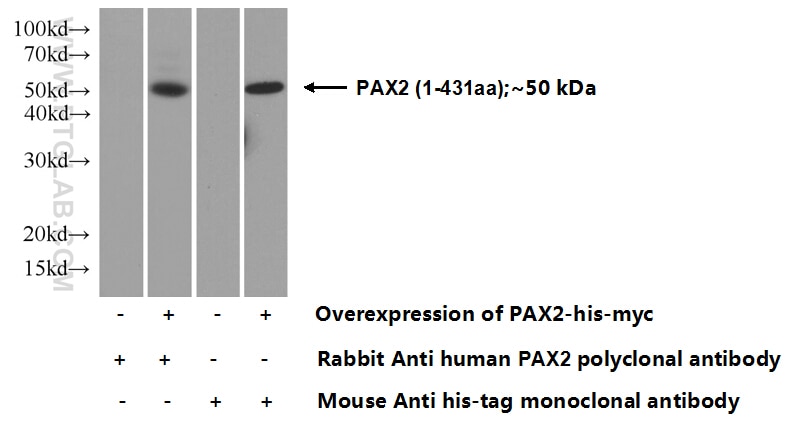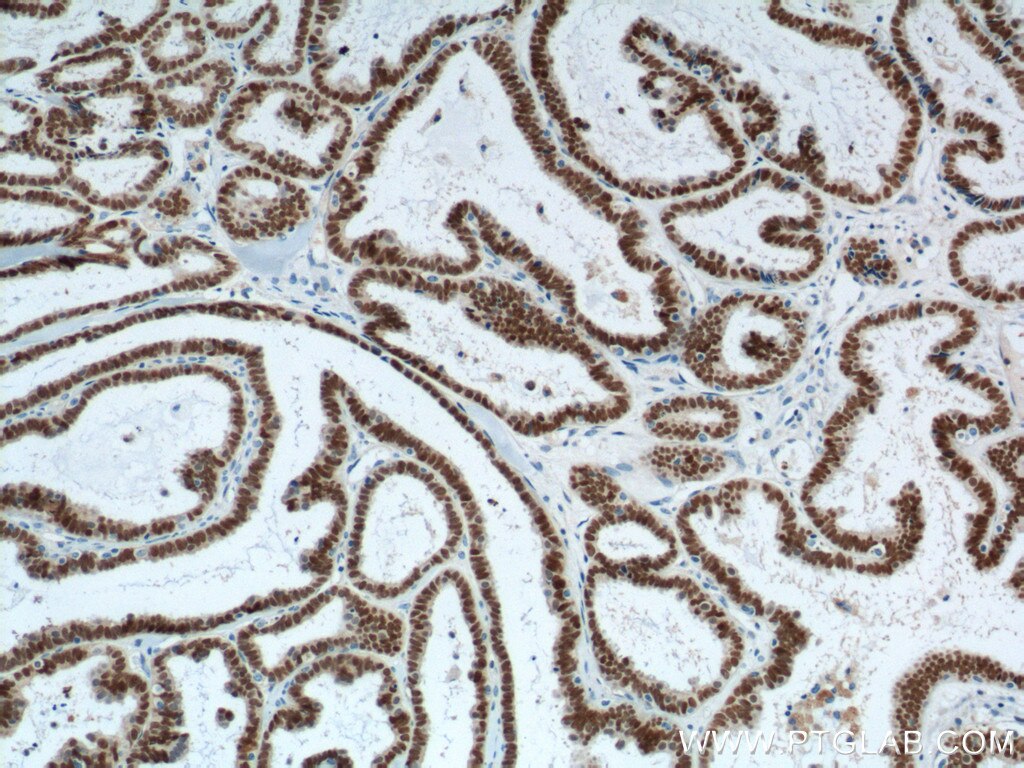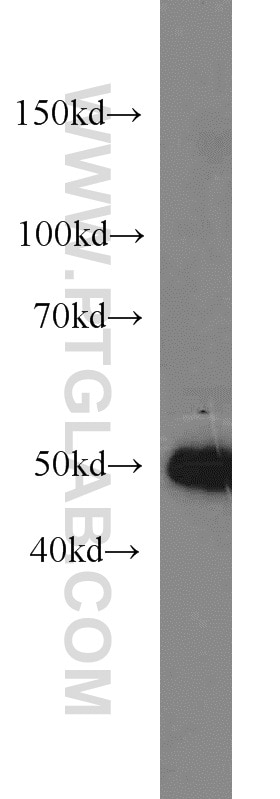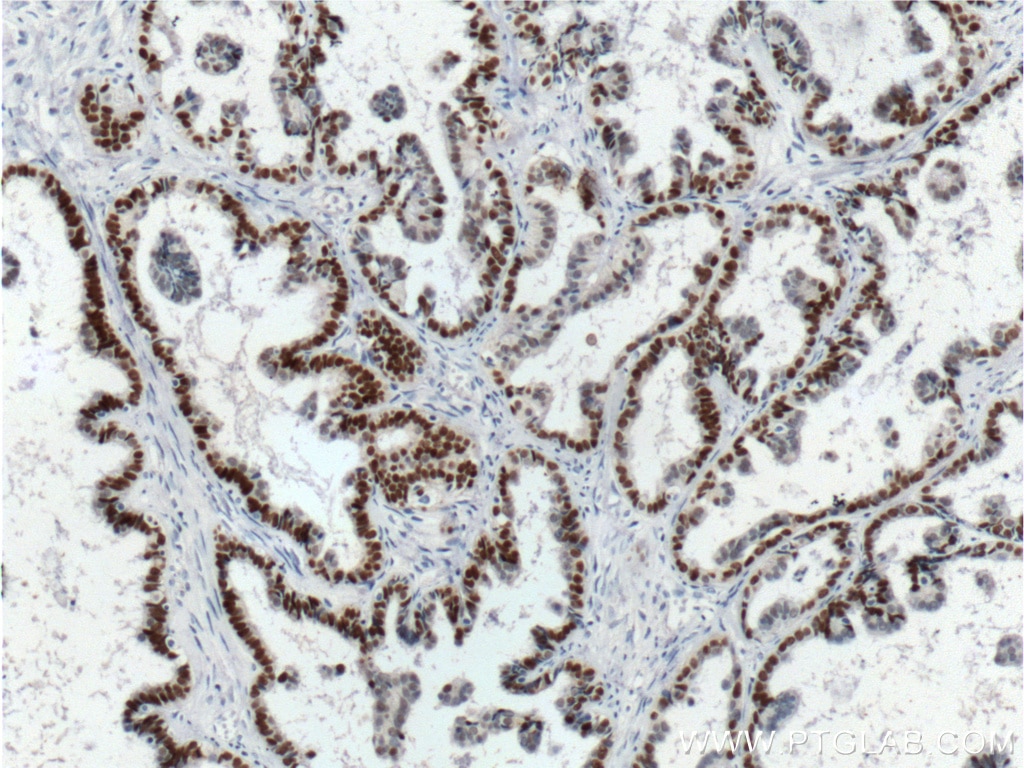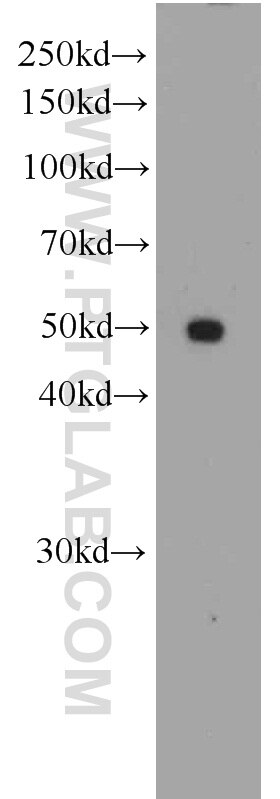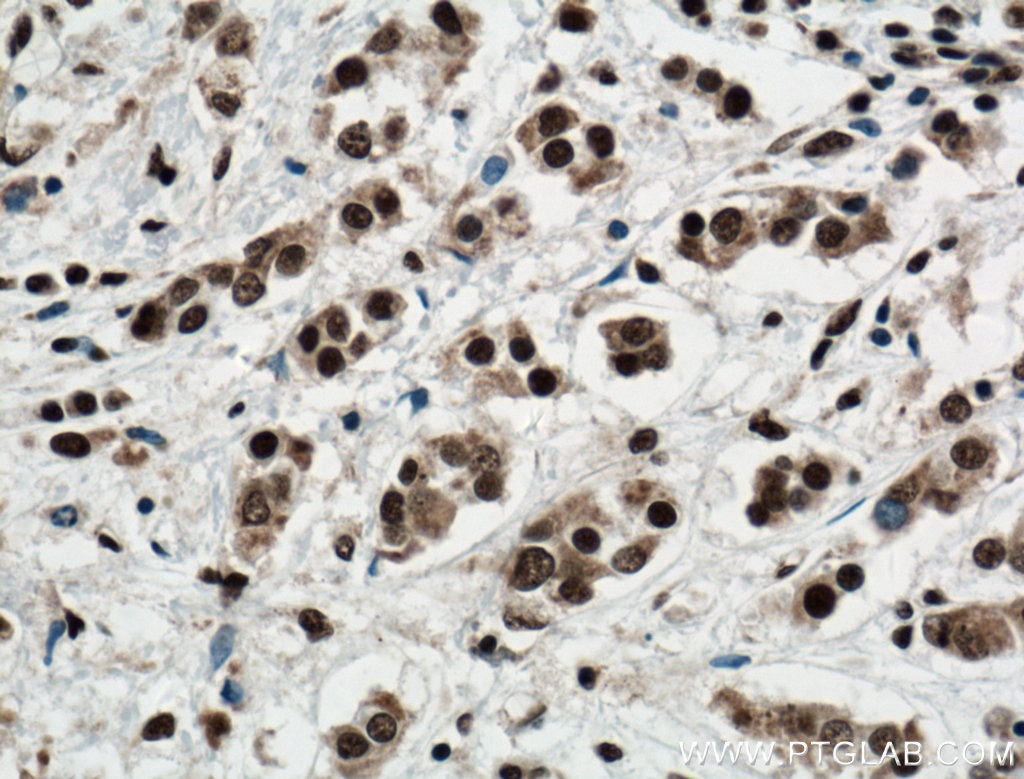WB Figures
WB analysis using 15539-1-AP
Various lysates were subjected to SDS PAGE followed by western blot with 15539-1-AP (Cytokeratin 7 antibody) at dilution of 1:10000 incubated at room temperature for 1.5 hours.
WB analysis of HeLa using 15539-1-AP
HeLa cells were subjected to SDS PAGE followed by western blot with 15539-1-AP (KRT7 antibody) at dilution of 1:600 incubated at room temperature for 1.5 hours.
WB analysis of A431 using 15539-1-AP
A431 cells were subjected to SDS PAGE followed by western blot with 15539-1-AP (KRT7 antibody) at dilution of 1:600 incubated at room temperature for 1.5 hours.
WB analysis of mouse liver using 15539-1-AP
mouse liver tissue were subjected to SDS PAGE followed by western blot with 15539-1-AP (KRT7 antibody) at dilution of 1:600 incubated at room temperature for 1.5 hours.
WB analysis of rat liver using 15539-1-AP
rat liver tissue were subjected to SDS PAGE followed by western blot with 15539-1-AP (KRT7 antibody) at dilution of 1:1500 incubated at room temperature for 1.5 hours.
IHC Figures
IHC staining of human pancreas using 15539-1-AP
Immunohistochemical analysis of paraffin-embedded human pancreas tissue slide using 15539-1-AP (Cytokeratin 7 antibody) at dilution of 1:25600 (under 10x lens. Heat mediated antigen retrieval with Tris-EDTA buffer (pH 9.0).
IHC staining of human pancreas using 15539-1-AP
Immunohistochemical analysis of paraffin-embedded human pancreas tissue slide using 15539-1-AP (Cytokeratin 7 antibody) at dilution of 1:25600 (under 40x lens. Heat mediated antigen retrieval with Tris-EDTA buffer (pH 9.0).
IHC staining of mouse pancreas using 15539-1-AP
Immunohistochemical analysis of paraffin-embedded mouse pancreas tissue slide using 15539-1-AP (Cytokeratin 7 antibody) at dilution of 1:1000 (under 10x lens). Heat mediated antigen retrieval with Tris-EDTA buffer (pH 9.0).
IHC staining of mouse pancreas using 15539-1-AP
Immunohistochemical analysis of paraffin-embedded mouse pancreas tissue slide using 15539-1-AP (Cytokeratin 7 antibody) at dilution of 1:1000 (under 40x lens). Heat mediated antigen retrieval with Tris-EDTA buffer (pH 9.0).
IHC staining of mouse kidney using 15539-1-AP
Immunohistochemical analysis of paraffin-embedded mouse kidney tissue slide using 15539-1-AP (Cytokeratin 7 antibody) at dilution of 1:12800 (under 40x lens). Heat mediated antigen retrieval with Tris-EDTA buffer (pH 9.0).
IHC staining of rat kidney using 15539-1-AP
Immunohistochemical analysis of paraffin-embedded rat kidney tissue slide using 15539-1-AP (Cytokeratin 7 antibody) at dilution of 1:10000 (under 10x lens). Heat mediated antigen retrieval with Tris-EDTA buffer (pH 9.0).
IHC staining of rat kidney using 15539-1-AP
Immunohistochemical analysis of paraffin-embedded rat kidney tissue slide using 15539-1-AP (Cytokeratin 7 antibody) at dilution of 1:10000 (under 40x lens). Heat mediated antigen retrieval with Tris-EDTA buffer (pH 9.0).
IHC staining of human lung cancer using 15539-1-AP
Immunohistochemical analysis of paraffin-embedded human lung cancer tissue slide using 15539-1-AP (Cytokeratin 7 antibody) at dilution of 1:12800 (under 10x lens). Heat mediated antigen retrieval with Tris-EDTA buffer (pH 9.0).
IHC staining of human lung cancer using 15539-1-AP
Immunohistochemical analysis of paraffin-embedded human lung cancer tissue slide using 15539-1-AP (Cytokeratin 7 antibody) at dilution of 1:12800 (under 40x lens). Heat mediated antigen retrieval with Tris-EDTA buffer (pH 9.0).
IHC staining of mouse kidney using 15539-1-AP
Immunohistochemical analysis of paraffin-embedded mouse kidney tissue slide using 15539-1-AP (Cytokeratin 7 antibody) at dilution of 1:12800 (under 10x lens). Heat mediated antigen retrieval with Tris-EDTA buffer (pH 9.0).
IHC staining of human kidney using 15539-1-AP
Immunohistochemical analysis of paraffin-embedded human kidney tissue slide using 15539-1-AP (Cytokeratin 7 antibody) at dilution of 1:8000 (under 10x lens). Heat mediated antigen retrieval with Tris-EDTA buffer (pH 9.0).
IHC staining of human kidney using 15539-1-AP
Immunohistochemical analysis of paraffin-embedded human kidney tissue slide using 15539-1-AP (Cytokeratin 7 antibody) at dilution of 1:8000 (under 40x lens). Heat mediated antigen retrieval with Tris-EDTA buffer (pH 9.0).
IHC staining of mouse kidney using 15539-1-AP
Immunohistochemical analysis of paraffin-embedded mouse kidney tissue slide using 15539-1-AP (Cytokeratin 7 antibody) at dilution of 1:8000 (under 10x lens). Heat mediated antigen retrieval with Tris-EDTA buffer (pH 9.0).
IHC staining of mouse kidney using 15539-1-AP
Immunohistochemical analysis of paraffin-embedded mouse kidney tissue slide using 15539-1-AP (Cytokeratin 7 antibody) at dilution of 1:8000 (under 40x lens). Heat mediated antigen retrieval with Tris-EDTA buffer (pH 9.0).
IHC staining of rat kidney using 15539-1-AP
Immunohistochemical analysis of paraffin-embedded rat kidney tissue slide using 15539-1-AP (Cytokeratin 7 antibody) at dilution of 1:8000 (under 10x lens). Heat mediated antigen retrieval with Tris-EDTA buffer (pH 9.0).
IHC staining of rat kidney using 15539-1-AP
Immunohistochemical analysis of paraffin-embedded rat kidney tissue slide using 15539-1-AP (Cytokeratin 7 antibody) at dilution of 1:8000 (under 40x lens). Heat mediated antigen retrieval with Tris-EDTA buffer (pH 9.0).
IHC staining of human lung using 15539-1-AP
Immunohistochemical analysis of paraffin-embedded human lung tissue slide using 15539-1-AP (Cytokeratin 7 antibody) at dilution of 1:8000 (under 10x lens). Heat mediated antigen retrieval with Tris-EDTA buffer (pH 9.0).
IHC staining of human lung using 15539-1-AP
Immunohistochemical analysis of paraffin-embedded human lung tissue slide using 15539-1-AP (Cytokeratin 7 antibody) at dilution of 1:8000 (under 40x lens). Heat mediated antigen retrieval with Tris-EDTA buffer (pH 9.0).
IHC staining of human stomach cancer using 15539-1-AP
Immunohistochemical analysis of paraffin-embedded human stomach cancer tissue slide using 15539-1-AP (Cytokeratin 7 antibody at dilution of 1:200 (under 10x lens).
IHC staining of human stomach cancer using 15539-1-AP
Immunohistochemical analysis of paraffin-embedded human stomach cancer tissue slide using 15539-1-AP (Cytokeratin 7 antibody at dilution of 1:200 (under 40x lens).
IHC staining of human ovary tumor using 15539-1-AP
Immunohistochemical analysis of paraffin-embedded human ovary tumor tissue slide using 15539-1-AP (Cytokeratin 7 antibody at dilution of 1:200 (under 40x lens). Heat mediated antigen retrieval with Tris-EDTA buffer (pH 9.0).
IHC staining of human breast cancer using 15539-1-AP
Immunohistochemical analysis of paraffin-embedded human breast cancer tissue slide using 15539-1-AP (Cytokeratin 7 antibody at dilution of 1:200 (under 10x lens). Heat mediated antigen retrieval with Tris-EDTA buffer (pH 9.0).
IHC staining of human breast cancer using 15539-1-AP
Immunohistochemical analysis of paraffin-embedded human breast cancer tissue slide using 15539-1-AP (Cytokeratin 7 antibody at dilution of 1:200 (under 40x lens). Heat mediated antigen retrieval with Tris-EDTA buffer (pH 9.0).
IHC staining of human ovary tumor using 15539-1-AP
Immunohistochemical analysis of paraffin-embedded human ovary tumor tissue slide using 15539-1-AP (Cytokeratin 7 antibody at dilution of 1:200 (under 10x lens). Heat mediated antigen retrieval with Tris-EDTA buffer (pH 9.0).
IHC staining of human lung cancer using 15539-1-AP
Immunohistochemical analysis of paraffin-embedded human lung cancer tissue slide using 15539-1-AP (Cytokeratin 7 antibody) at dilution of 1:10000 (under 10x lens). Heat mediated antigen retrieval with Tris-EDTA buffer (pH 9.0).
IHC staining of human lung cancer using 15539-1-AP
Immunohistochemical analysis of paraffin-embedded human lung cancer tissue slide using 15539-1-AP (Cytokeratin 7 antibody) at dilution of 1:10000 (under 40x lens). Heat mediated antigen retrieval with Tris-EDTA buffer (pH 9.0).
IHC staining of human liver cancer using 15539-1-AP
Immunohistochemical analysis of paraffin-embedded human liver cancer tissue slide using 15539-1-AP (Cytokeratin 7 antibody) at dilution of 1:200 (under 10x lens. Heat mediated antigen retrieval with Tris-EDTA buffer (pH 9.0).
IHC staining of human liver cancer using 15539-1-AP
Immunohistochemical analysis of paraffin-embedded human liver cancer tissue slide using 15539-1-AP (Cytokeratin 7 antibody) at dilution of 1:200 (under 40x lens. Heat mediated antigen retrieval with Tris-EDTA buffer (pH 9.0).
